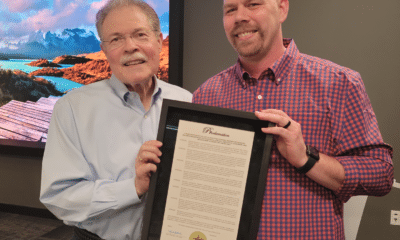Community
The Holidays Are Coming
Published
3 years agoon
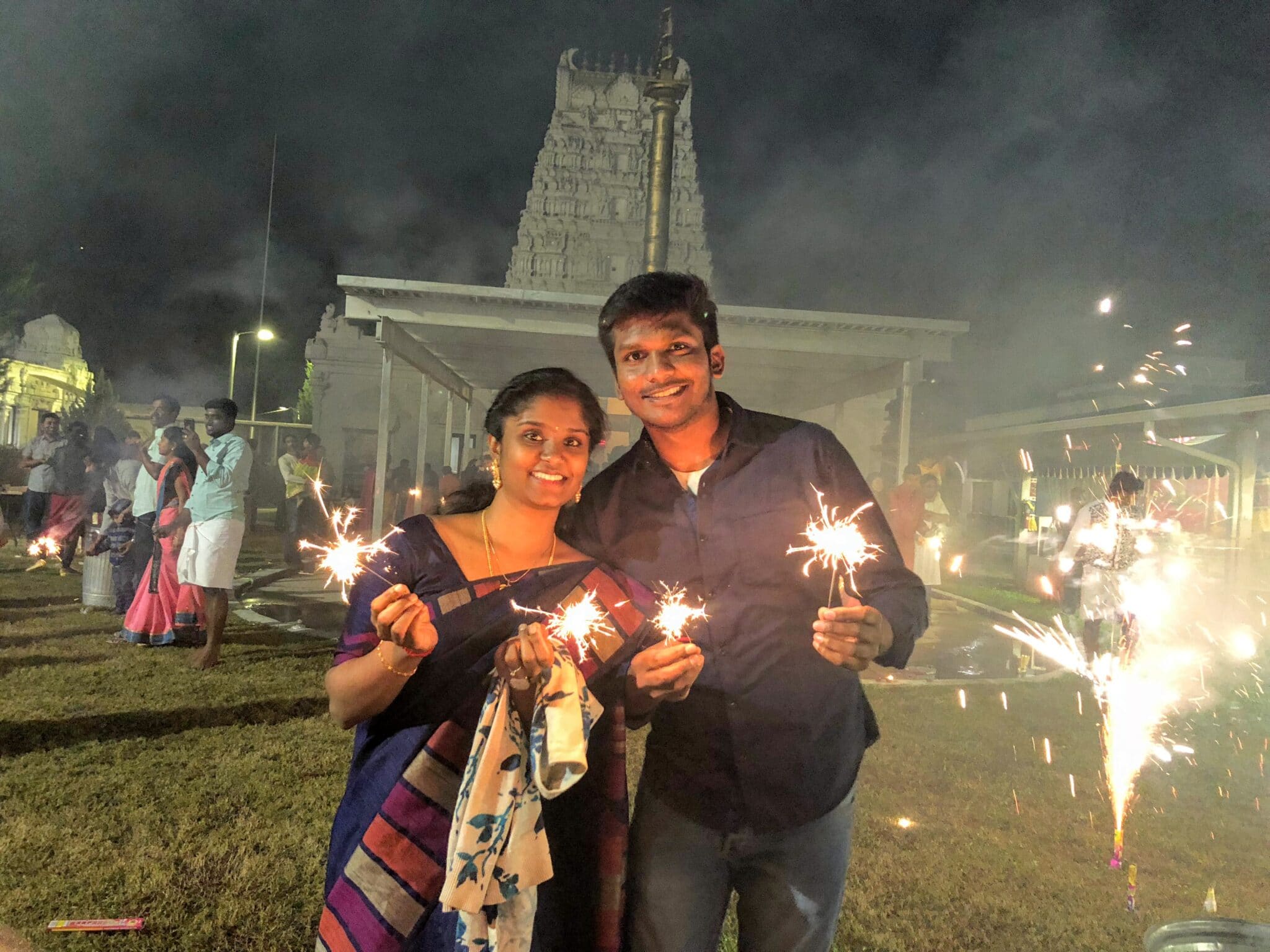
How Peachtree Corners sparkles during the holiday season
The holidays are upon us, and what ignites the holiday spirit within us can be as unique as our fingerprints. Decorations, traditions and holiday carols do it for this Catholic Canadian of Italian heritage, now American – it begins with that first slice of panettone, an Italian sweet bread.
When the house is brimming with cards, garlands, ribbon, the irresistible aroma of baked cookies, beautifully wrapped presents, all set aglow by the soaring North Carolina Frasier Fir glimmering in the living room — its angel topper precariously perched yet sweetly smiling down upon my family from the top — it feels like Christmas.
Psst! I slip baby Jesus into the manger as soon as I set up the nativity, knowing full well I’m supposed to wait until Christmas.
The anticipation of Christmas Eve mass is almost more than I can bear; it inexplicably fills me with the purest feeling that all is right in the world. Of course, Christmas morning has its own charms — comfy jammies, fun surprises and the joy of spoiling our loved ones. Since I love the season so much, I wondered what fellow residents of Peachtree Corners cherished most about their holidays.
What do the holidays mean to you?
Diversity is part of what makes Peachtree Corners special. Multiple faiths and backgrounds are represented here, and within each of those, different aspects of religious and cultural observances are responsible for the city’s unique holiday sparkle, bringing cheer to all.
My gift to you is a glimpse into an assortment of revelries that may differ in many ways from your own, but for one common denominator — they all bring warmth and light to an otherwise cold and dark time of year.
Diwali- November 4-8
Diwali is a festival of lights celebrated by Hindus, Sikhs, Jains and some Buddhists around the world at the new moon in the month of Karthik (October-November). It’s a celebration of the spiritual victory of good over evil, light over darkness, and knowledge over ignorance.
Hailing from southern India, Parnitha Selvaraj speaks Tamil, the world’s oldest living language. She and her family have been celebrating Diwali, or Deepavali, in Peachtree Corners since 2019.
Observance and tradition
“We wake up early, take an oil bath before sunrise, wear our finest clothes and say our prayers. We take blessings from our elders in the family,” Selvaraj said. “A week before, we shop for nice clothing and joyfully prepare a variety of sweet and savory foods at home, to be shared with extended family and friends.”
“We draw colorful kolam or rangoli at our entrance as part of the festival decorations,” she added. Colored rice, rice powder or sand is used to create this traditional decorative floor art. The colorful, intricate patterns symbolize happiness and prosperity. They announce auspiciousness, that all-is-well in the household. Drawing kolams signifies that Goddess Lakshmi is welcome, while poverty, illness, laziness and bad luck is banished.
Favorite memories
“My favorite part was mom’s special breakfast, bursting firecrackers and colorful fireworks – we were mesmerized as kids,” Selvaraj said.
Her fondest memories are spending time with family and friends and “eating traditional wheat halwa (sweet pudding), a delicacy prepared by my grandmother,” she said, as well as “celebrating our culture, conveying the significance of the festival to our next generations.”
“The celebration gives reaffirmation of hope, a renewed commitment to goodwill, the feeling of greeting people and being greeted by everyone we meet,” Selvaraj said.
Family traditions
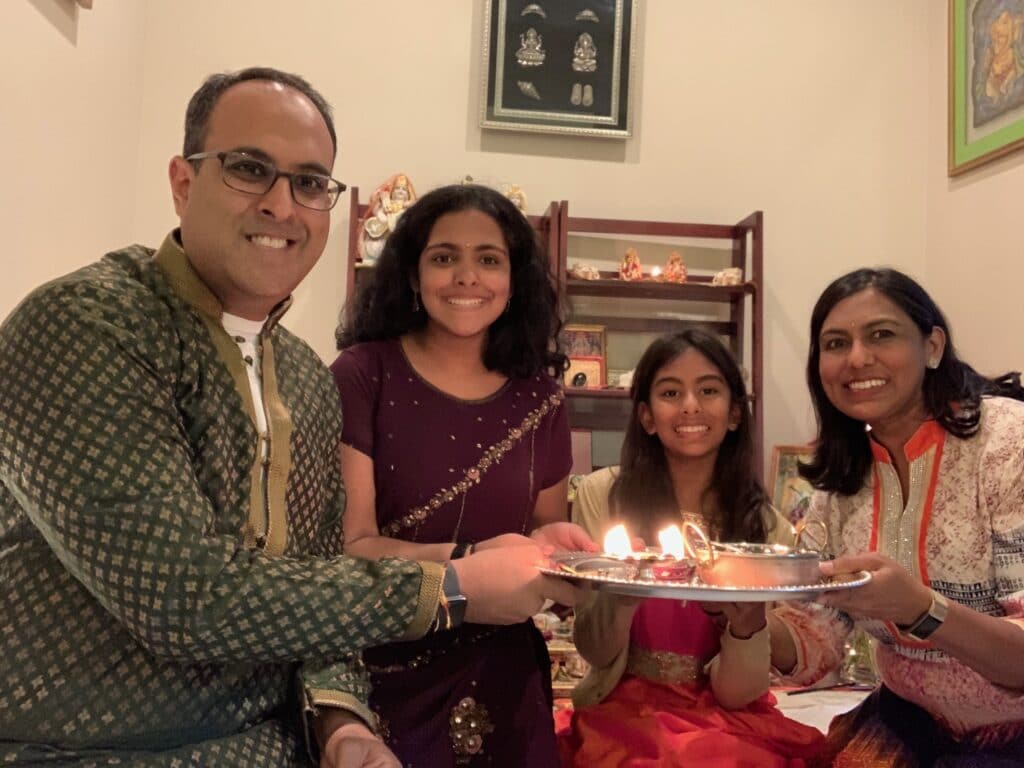
From northern India, Seema Gupta has been celebrating Diwali with her Hindu family in Peachtree Corners for eight years. Based on the lunar calendar, the days of celebration vary from year to year.
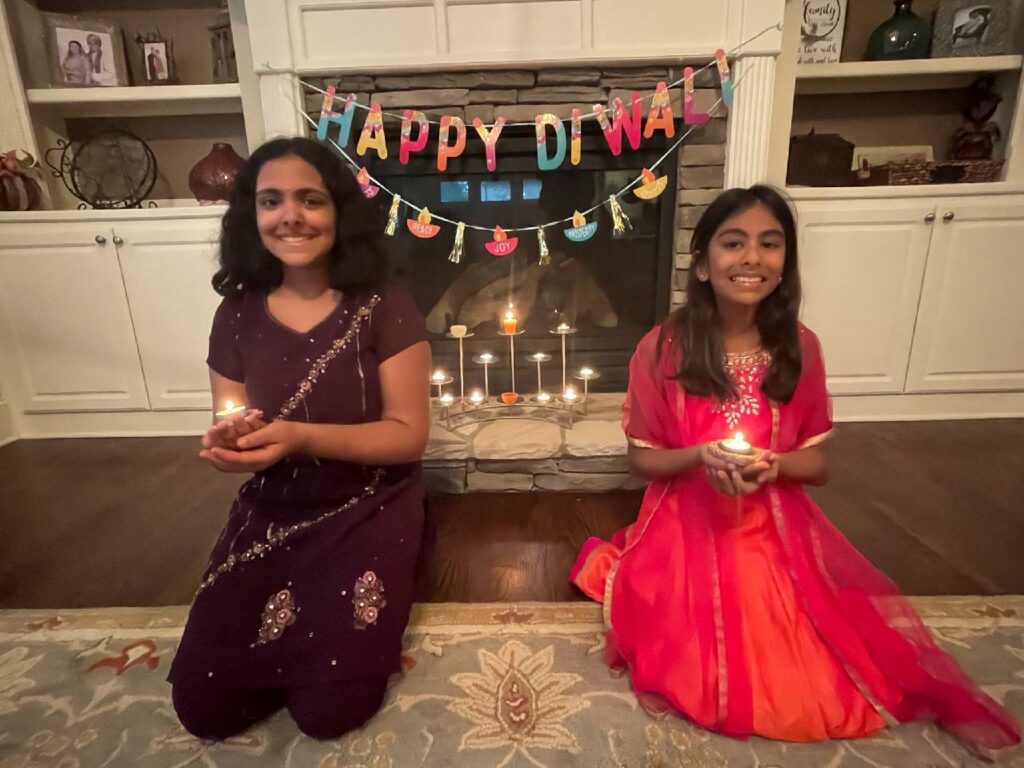
One of the most celebrated holidays in India, Diwali gets its name from the row (avali) of clay lamps (deepa) that people light outside their homes. It’s the celebration of Lord Rama’s return to his kingdom Ayodhya, with his wife Sita and his brother Lakshmana, after defeating the demon-king Ravana and serving 14 years of exile.
“We love to dress in traditional Indian clothing, then do a pooja (a worship ritual) at our house, where we offer prayers to Goddess Lakshmi, so that the Hindu New Year is filled with peace, wealth and prosperity,” Gupta said.
“We decorate the entire house (inside and outside) with lights and candles. We also make rangoli with colored rice. Afterwards, we enjoy a delicious Indian feast with family, and light sparklers and fireworks at night.”
Shared traditions
“We have enjoyed going to the BAPS Shri Swaminarayan Mandir (Temple) in Lilburn to see an amazing display of fireworks,” Gupta added. “Diwali is like Christmas and New Year’s Day wrapped into one big holiday! We love sharing the traditions with our children and celebrating with family and friends.”
Celebration of family
Vipul Singh was born in Patna, India and celebrates Diwali with his multicultural family in Peachtree Corners since their recent move here. He grew up in a Hindu household, cherishing Diwali as one of the most important festivals of his childhood, while his wife Lindsay was born and raised in Pennsylvania.
With several origins in the Hindu religion, most families celebrate Diwali across five days as a victory of good over evil and the start of a new year. Some take holidays to distribute gifts to friends and relatives. It’s a time for families to reset and take time to check on their well-being over the past year.
Traditions and memories
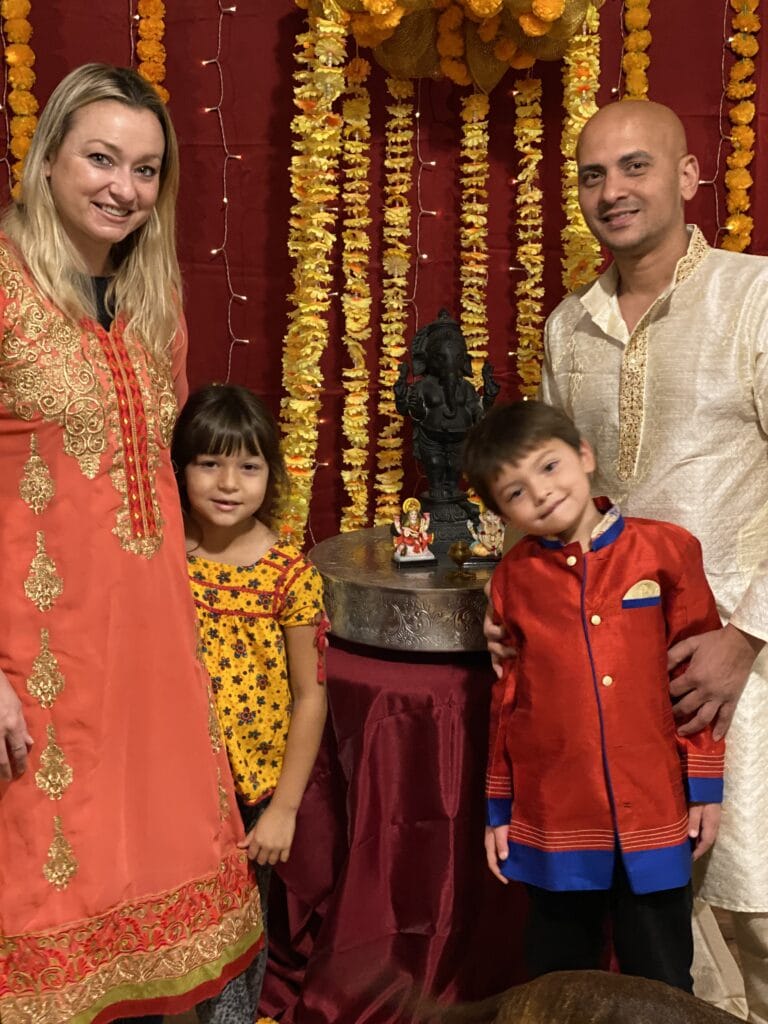
Singh said his family traditions include “meeting family and friends, enjoying Indian food, and fireworks, placing lights outside which stay on until Christmas for neighbors to enjoy.”
Children often travel hundreds of miles to visit parents. It’s a time of gathering and rejoicing. People decorate their homes after a fall clean-up.
“There were lots of fireworks the year my younger sister was born,” Singh said. “Daughters are considered a version of Goddess Lakshmi (Goddess of wealth), so we celebrated a bit more.”
His favorite feature of Diwali, he said, is seeing the joy in the eyes of the kids.
Hanukkah November 28-December 6
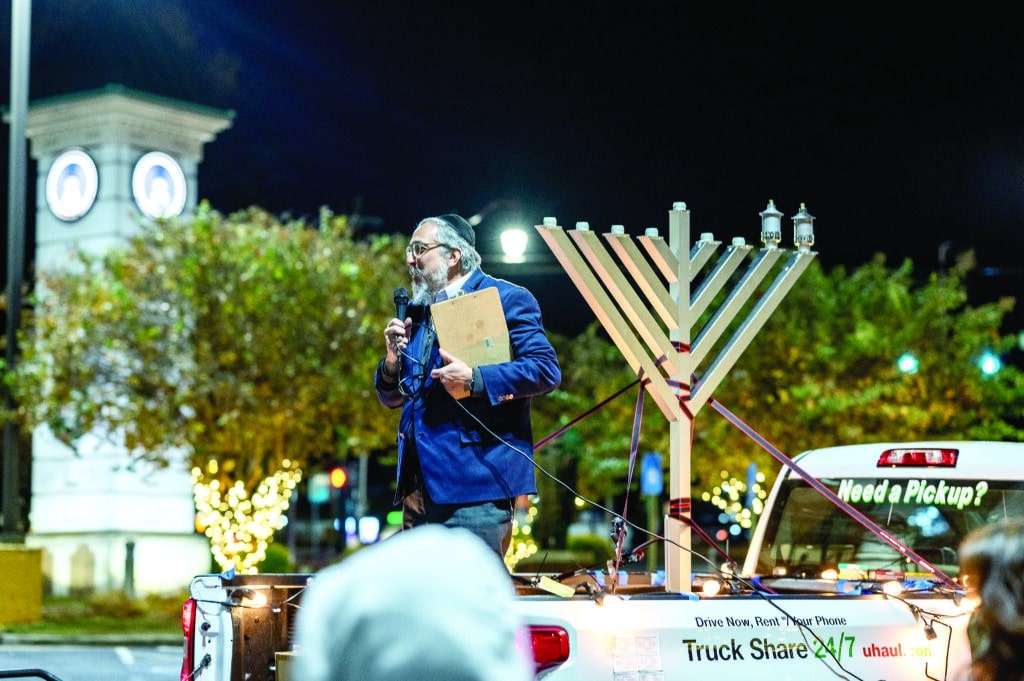
Spiritual leader of Judaism, Rabbi Yossi Lerman is President of the Chabad Enrichment Center of Gwinnett. He’s been celebrating Hanukkah in the Peachtree Corners area for 20 years and delivers an exceptionally concise and interesting account of the origins of the Jewish festival of lights, “Hanukkah epitomizes a determination to see life through a positive lens.”
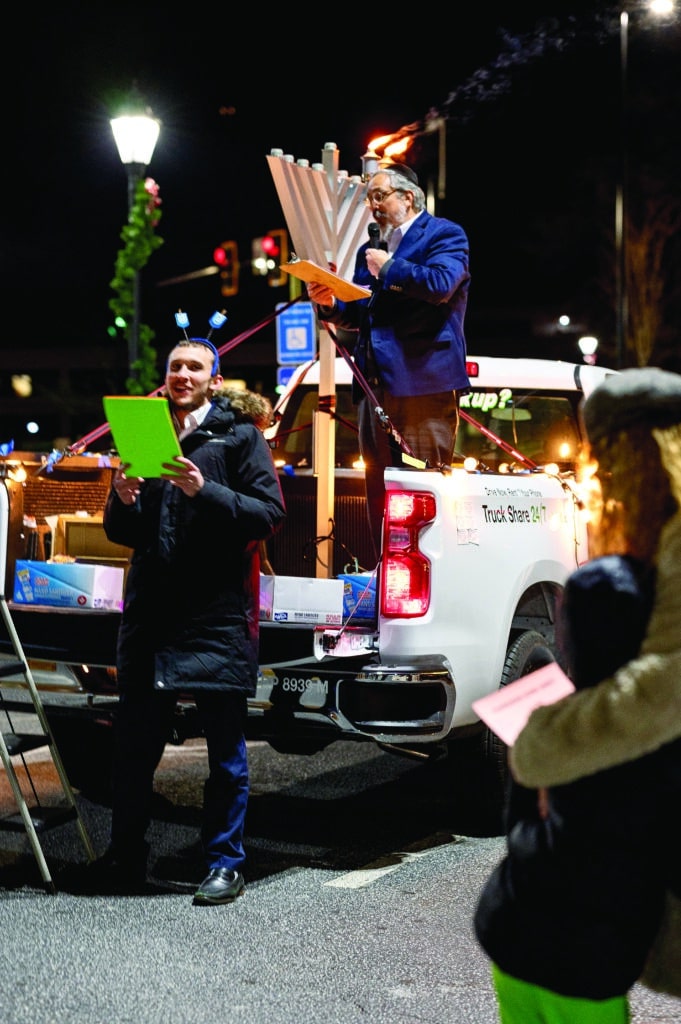
Under Alexander the Great, the Greek and Hebrew cultures were allowed to flourish simultaneously. When Antiochus Epiphanes reigned in Jerusalem (175-164 BCE), he was tyrannical, forcing his Greek ways upon the Jewish people.
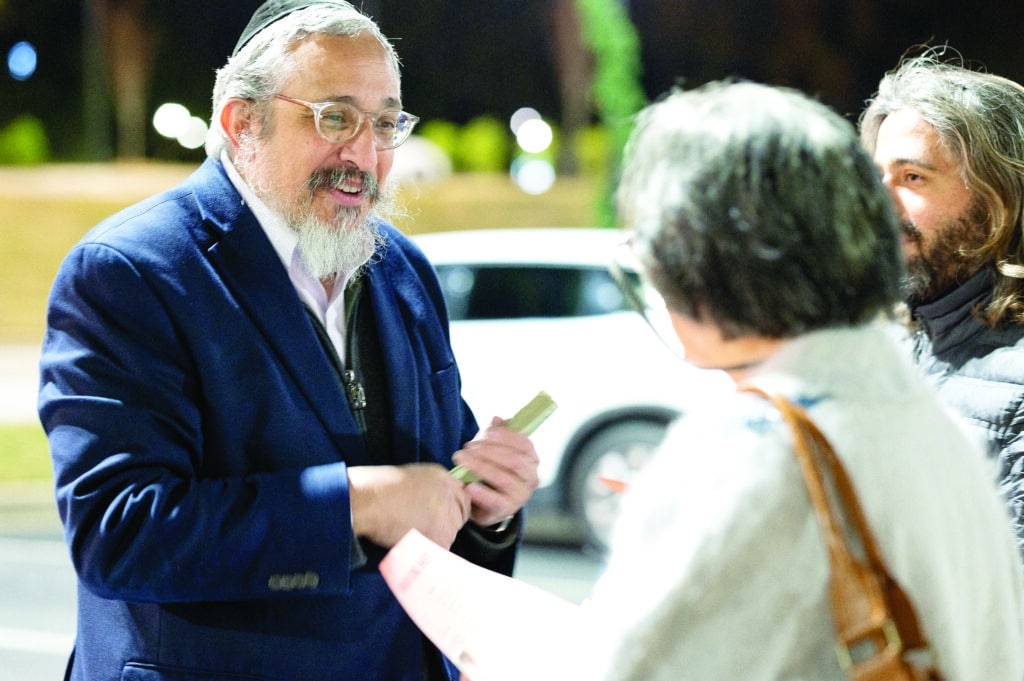
Religious observance
Hanukkah commemorates the military victory of the Jews revolting and regaining access to the holy temple that had been desecrated by the Greeks (which was a miracle in itself: a small band of Jewish fighters against the mighty Greek forces) as well as the miracle of the oil.
Finding only one jug of oil intact after the Greeks had vandalized everything, they lit the menorah (candelabra) which should only have lasted one night. Instead, it lasted eight days, giving them time enough to produce new oil. They had to travel to the Judea hills, where olive trees grew, to make new olive oil.
“We don’t like to talk about war, or even celebrate the fact that we won that war,” Rabbi Lerman said. “We do celebrate the miracle of finding the jug of oil and its lasting eight days instead of one, so we call it the Festival of Lights. We’re into the constructive message. If we can turn the lights on, we can have a positive perspective on life.”
Traditions and memories
The rabbi shared some Hanukkah traditions:
■ Foods that are baked or fried in oil, like potato latkes and fried donuts made with various fillings like cream or jelly, to memorialize the jar of oil through which the miracle occurred.
■ Lights are kindled every evening for the eight days of the holiday.
■ Children play dreidel (spinning the Hanukkah top).
A favorite memory is getting Hanukkah gifts for eight days. (Hanukkah gift-giving predated Christmas by 200 years). “The main emphasis is getting the children excited,” Rabbi Lerman said.
“Gelt is the Yiddish word for money. I give cash instead of gifts to my seven children, encouraging them to spend some, save some and give some away,” he said. “This becomes an educational piece on how to use money in life.”
Another favorite aspect is the public menorah lighting, Rabbi Lerman said. “We’ll be doing four outdoor menorah lightings in Gwinnett County, open and free to the public in Duluth, Suwanee, Lawrenceville and one at the Forum on December 5th.”
Saint Lucia Day December 13
78-year-old Realtor Christine Robinson was born in Lulea, in northern Sweden, where she grew up in the Christian traditions of the Lutheran church and was educated through college. For 37 years, she has kept the holiday traditions of her native royal kingdom alive in this area, well before it became incorporated Peachtree Corners.
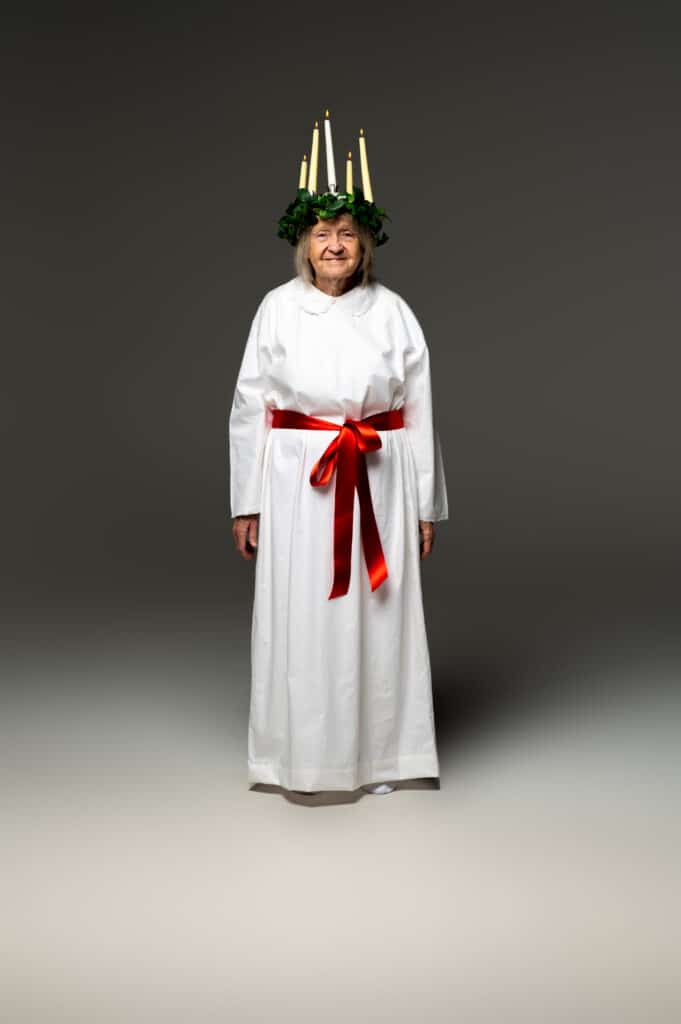
Saint Lucia Day is celebrated by Lutherans, Roman Catholics and Anglicans. It’s the story of a young Christian girl from Syracuse, Sicily, who was brutally martyred by the Romans in 304 CE.
Legend has it she wore a crown of candles to light her way as she brought food to persecuted Christians hiding in the Roman catacombs.
All of Sweden celebrates the Queen of Light — every city, airline, school, hospital, nursing home and church.
Family traditions
A beautiful young lady wearing a long white dress and a crown of live candles on her head comes early in the morning with her attendants behind her carrying one candle each, singing the famous Italian song, “Santa Lucia.”
“Where I’m from, the sun doesn’t come up for two months in winter because it’s so far north, so it’s quite something to see. It’s very special,” Robinson said.
“I’ve observed this tradition with my children, neighbors, friends and grandchildren over the years. I invited young girls to my home (to be my attendants). We’d all wear the long white gowns. I decorate the crown with fresh greenery. I turn off all the lights in the house, light the candles, turn on the music and sing.”
She added, “Some of the young boys watching said, “This is what it must be like in Heaven. You look like angels.””
Fondest memory
Robinson always enjoys seeing “all the girls in white gowns arriving, Lucia with the candles on her crown.” She shared a special memory: “The first time my daughter was Lucia, she was two years old. I dressed her up as Lucia with battery candles. She knew exactly what to do. She even served the Lucia buns (saffron bread rolls).”
Advent November 28-December 24
Robinson also celebrates Advent during the four weeks leading up to Christmas in keeping with Christian churches of the western tradition: Catholic, Anglican, Episcopalian, Lutheran and some Protestant churches. Every Sunday during mass, a candle is lit on a wreath presented horizontally, in preparation for the coming of Jesus Christ. The candles symbolize hope, love, joy and peace.
Family traditions and memories
On the first day of Advent, a star of paper, straw or metal goes up in one of the windows in every household, to recall the star that the three wise men followed to Bethlehem. “My dad put a lamp inside our paper star,” Robinson said.
“Advent starts four Sundays before Christmas. We would gather as a family, turn the lights off and light the first candle on the first Sunday, and then one more each Sunday until Christmas,” she continued. “My dad read from the Old Testament how it was declared that a child would be born. We had a little prayer.” Then her mother played the piano, and the family sang Christmas songs and ate gingerbread cookies.
“We had an Advent calendar with small boxes; you open one per day,” Robinson said. “Now they have candy or presents, but I was born during the war; we were so poor.” “We had little pictures in our boxes; it could be of a Christmas tree, a squirrel, a bird, candles. We were excited just to open the box to see what the picture was,” she added. “I took turns opening the boxes with my two younger brothers, sometimes cheating and peeking in the boxes ahead of time.”
Christmas December 25
The same Christian churches that celebrate Advent celebrate Jesus’ birthday. Christians believe that Jesus is the son of God, born as man to save us from our sins, the Messiah foretold in the Hebrew Bible and the Christian Old Testament.
Family traditions
Robinson said that, in Sweden, her family brought the tree in on the 23rd “and decorated it with our famous straw ornaments, ginger cookies and handmade ornaments. Today I start decorating much earlier. I have 11 Christmas trees. My Christmas room full of decorations is sacred.”
She does a lot of special cooking and baking in December. “I bake Swedish cookies; jam, gingerbread, oatmeal, a jelly roll (with my own jam) and saffron bread,” Robinson said.
“We used to order ham from Chicago – they prepared it like in Sweden, not like Honey Baked Ham. It’s more like country ham. Christmas meal is ham and potatoes (casserole or mashed), some different vegetables here, and in Sweden, rice porridge for dessert.”
For Robinson’s family, Santa comes in person to deliver gifts on Christmas Eve. “He knocks on the door asking, “Are there any nice kids in this family?” In the 40s after the war, we got three presents each,” she shared. “One was practical (clothes, skis), a toy and a bag of candy that we’d never get during any other time of the year. There was no money for candy. We opened gifts on Christmas Eve.”
Fondest memories
Robinson fondly remembers “being with family — aunts, uncles, cousins. Playing games, singing and eating.”
Her favorite part is “celebrating Christ’s birth!” she said. “On Christmas morning the old churches in Sweden ring the church bells, some of them over 500 years old. The service starts at 7 a.m. Only candles light these big old churches. The Pipe organ plays, and the choir sings traditional carols like “Silent Night.” I can still hear and feel the incredible voices and message of hope and peace ringing out in churches!”
The Twelve Days of Christmas
Peter Molloy was born in Ireland and raised as a Catholic. He’s lived in Peachtree Corners since 2005. Unlike many Americans, he still observes The Twelve Days of Christmas, the period between Jesus’ birth and the arrival of the Magi that has been celebrated since before the Middle Ages. That’s what “The Twelve Days of Christmas” song refers to — the 12 days after the birth of Jesus, to the Epiphany.
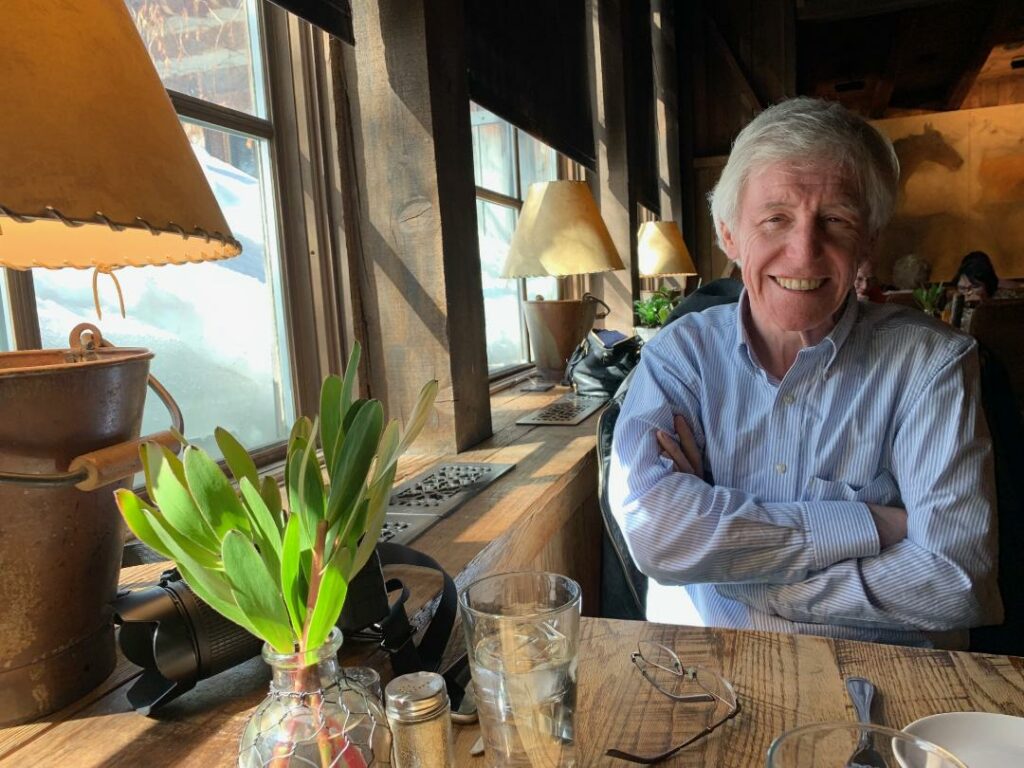
Religious observance
Molloy said he’s always focused on the religious component of Christmas growing up. “I spent most of my childhood in Ireland. Christmas did not truly start until Christmas Eve and continued until January 6th, Little Christmas.” Also known as The Epiphany, it’s the day the three wise men went to see baby Jesus in Bethlehem led by a miraculous star, and offered him gifts of gold, frankincense and myrrh.
Christmas decorations didn’t go up until after the children went to bed on Christmas Eve, according to Molloy. “Then they stayed up until Little Christmas. I do put the decorations up earlier now.”
“I’m truly bothered when people dispose of their Christmas tree on the day after Christmas,” he said. “Don’t they realize Christmas has just started?”
Peter Malloy livestreams the mass on the church YouTube Channel. He said, “We probably have the best live-streaming with a four-camera system. Watching, you can appreciate mass more than you would sitting at the back of the church.”
Traditions old and new
Molloy said he has fond memories of “going to midnight mass on Christmas Eve with our family doctor and close family friends, the Fall family.”
These days, he’s very involved with his church — Mary Our Queen Catholic Church. “I help usher all four masses on Christmas Eve and then go back on Christmas morning to attend mass,” he said. “Our church is beautiful at Christmas; it’s a joy to be there over the Christmas season.”
He’s part of a group of close friends that have agreed to pick one name out of a hat; each person is only allowed to spend $100. “This simplified gift giving is a lot more fun,” Molloy said. “It greatly reduced the stress of Christmas for us and allowed us to enjoy our friendship without worrying that someone might be disappointed.”
“We all finally get to slow down for a couple of days,” he continued. “In Ireland the country shuts down for a few days. I wish stores would not be in such a big hurry to open back up. I’ve never gotten over how commercialized Christmas has become. I suspect this is also the case in Ireland now.”
Family and food
Bruno Chidozie Okonkwo moved to Peachtree Corners in 2018. He is from the southeastern part of Nigeria, Imo state, in west Africa. His native language is Igbo. His wife, Rita, attended Peachtree Elementary School. They were married at Mary Our Queen Catholic Church.
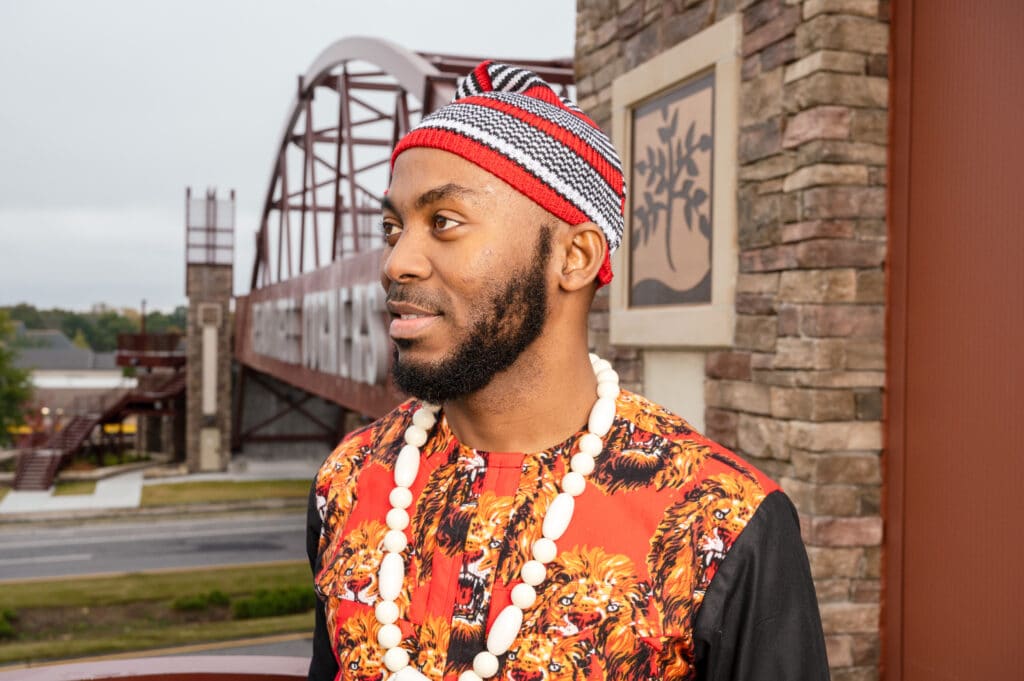
“We are Catholic Nigerians,” Okonkwo said. “During Advent we say prayers to prepare our hearts for the birth of Christ. We attend Christmas Day mass.”
Large quantities of food are prepared to have ready for guests, he explained. Favorite dishes include fried chicken; roasted goat; jollof rice with a base of tomato sauce, oil and spices; nkwobi (cooked cow foot); fufu (doughy balls of cassava) with egusi soup, prepared with ground melon seed, goat meat, crayfish, palm oil, bitter-leaf or spinach, onions and dried mackerel; ukwa (African breadfruit seed) prepared like black eyed peas; and ugba (shredded oil bean) salad. A popular drink is fresh palm wine.
“We like to travel to Nigeria as often as we can during Christmas time,” Okonkwo said. “In Nigeria, most travel to “the village” (hometown) from the city to celebrate. My family did so every Christmas season until just after New Year’s. It’s a special time for reunions with extended family and friends. My siblings, cousins and I would visit relatives’ homes where we were welcomed and fed by our aunties.”
These visits made according to market days are called Erigwara (eat mine, I eat yours) — a wonderful custom. There are four market days in Igboland: Eke, Orie, Afor and Nkwo. Every village has a market day. “We visit relatives and friends according to their market days and eat any food they’ve prepared,” he said. “On our market day, Eke, we expect friends and family to come spend all day eating and drinking.”
Traditions and memories
“Weeks in advance, we decorate our home and put up a Christmas tree and a nativity both here and in Nigeria,” Okonkwo said. “After mass on Christmas Day, we come back home to cook, eat and be merry. At mass in Nigeria, we sing hymns in both Igbo and English. Here we attend mass at Mary Our Queen.”
Gifts are opened prior to Christmas Day in Nigeria. “If you buy someone clothes or jewelry, it’s called Christmas cloth, and they will likely wear it on Christmas Day. Here, we open gifts when we come back from mass,” he explained.
Okonkwo’s favorite holiday memories are the family reunions, and his favorite part of Christmas is “being reminded of the gift of our Christian faith and celebrating it with dear ones — the celebration of God’s love for mankind.”
Kwanzaa December 26- January 1
Kwanzaa is a celebration of African American culture. Founder and Director of the Georgia Wholystic Center Wiletha Williams celebrates both Christmas and Kwanzaa. She has called this area home for 37 years.
A time of learning, family and celebration
Williams explained that Kwanzaa isn’t religious, it’s cultural. “We have been celebrating Kwanzaa in Peachtree Corners since 1994. We usually pick a Friday or Saturday between December 25 and December 30. We send an invitation to friends and family.”
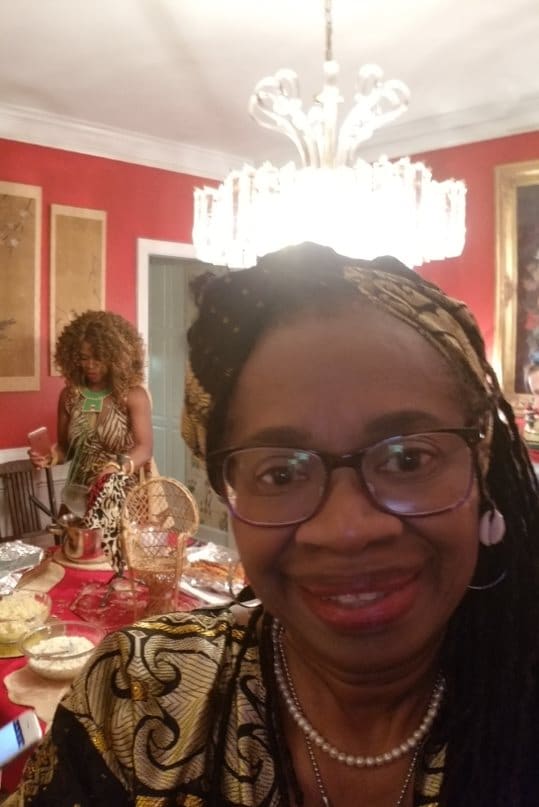
People come together to feast, honor ancestors, affirm their bonds and celebrate African culture. On each of seven days, a candle is lit, highlighting that day’s principle. Reciting sayings or writings of great Black thinkers and writers, original poetry, drumming and sharing a meal bring the principles to life.
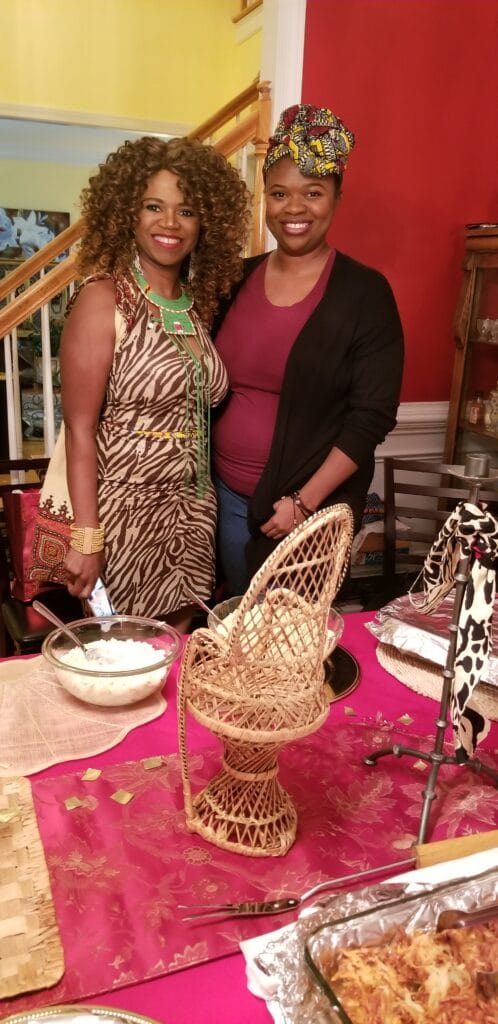
Table decorations include the symbols of Kwanzaa: the Kinara (candle holder), Mkeka (mat), Muhindi (corn representing the children), Mazao (fruit representing the harvest) and Zawadi (gifts).
Traditions and memories
“I love Christmas trees and other decor, music and cooking family favorite recipes: turkey, dressing, macaroni and cheese, green bean casserole, potato salad,” Williams said.
“For my 70th birthday, my son surprised me. He chartered a helicopter which picked us up in front of our house in Amberfield. After a tour of Atlanta, we landed at the 57th Fighter Group for dinner.”
Her favorite part of the holiday is spending time with family and friends, watching sports and movies. “Everyone brings a dish to add to the feast, while we provide the basics,” Williams said.
“We play games related to Kwanzaa facts, such as how the holiday was started in 1966 by Dr. Maulana Karenga in California.”
The family also discusses the Seven Principles of Kwanzaa:
• Umoja (unity in the family, community, nation and race),
• Kujichagulia
(self-determination),
• Ujima (collective work
and responsibility),
• Ujamaa (cooperative
economics),
• Nia (purpose),
• Kuumba (creativity) and
• Imani (faith).



“Everyone has the opportunity to perform dance, poems, songs or whatever they want. Music and dancing are enjoyed by all,” Williams said. “We try to get the children interested. Often, we honor ancestors by sharing pictures and stories of their lives.”
She said that, of course, the highlight is the feast (Karamu), which consists of a variety of traditional and contemporary dishes, including Southern dishes like collards and lima beans, buffalo wings, chili, sweet potato pie and cakes.
Chinese New Year February 1
Jun Lin emigrated from China in 2007 and has resided in Peachtree Corners for eight years. She observes Chinese New Year with her multiethnic family within the constraints of American work schedules and HOA covenants.
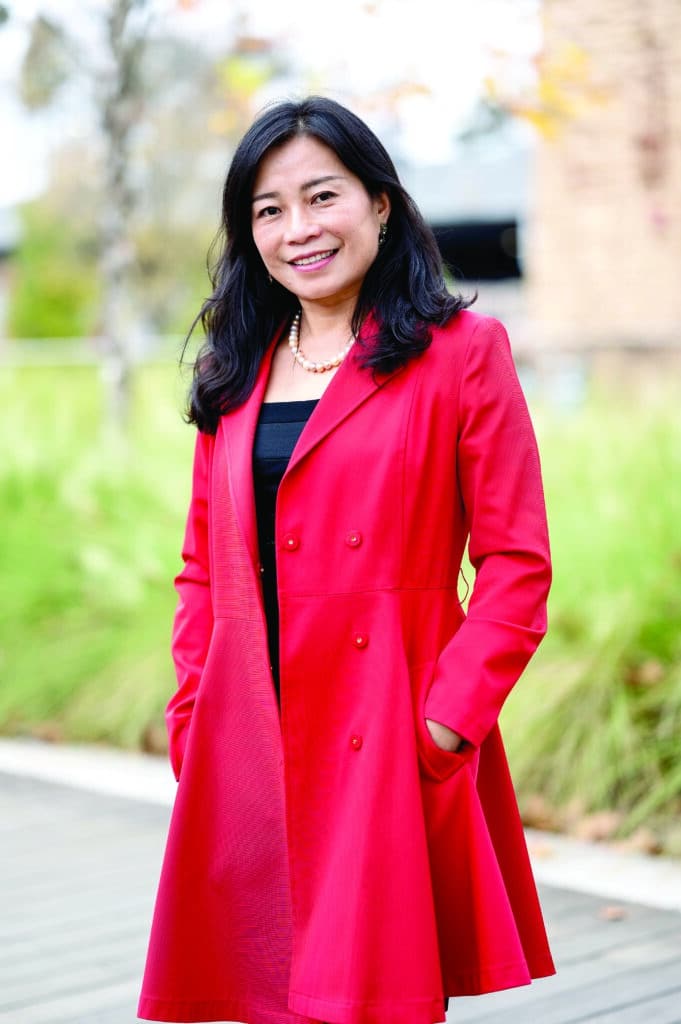
Chinese New Year is not a religious observance. Based on the lunisolar Chinese calendar, it’s the biggest cultural holiday celebrated in China and other Asian countries. It usually falls on the second new moon after the winter solstice, marking the transition from one Chinese animal zodiac sign to the next. 2022 is the year of the Tiger.
Chinese New Year is also known as Lunar New Year and Spring Festival. On the calendar of solar terms, the start of Spring falls on February 5th. It’s not necessarily a reflection of meteorological reality, yet it represents heading towards Spring and new beginnings.
Some businesses start two to four weeks before, and continue festivities two to four weeks after, the New Year. It’s the longest holiday and creates a massive travel rush known as Spring Movement.
Family traditions
“It was my favorite holiday when I was a kid because we got new clothes and gifts from our parents,” Lin said. “The whole month was a time to visit relatives.”
“Growing up, families started food preparation a month ahead since we didn’t have refrigerators. People bought pigs in the village where farmers would slaughter and butcher them.”
The pork would be brought back, seasoned and left to marinate for days. It was then set atop dried branches of pinewood and smoked, resulting in a month’s supply of meat similar to bacon.
“Two weeks before, my mom would soak sticky rice and then grind it into powder. When guests came to visit, she would cook the smoked meat and make Tangyuan, a soup of sweet rice balls with brown sugar, orange peel and sesame inside. The round shape signifies full accomplishment,” Lin explained. “Everything smelled and tasted so good, it was the taste of Chinese New Year.”
Fond memories
She added that on New Year’s Eve everyone watched a gala on TV which showcased popular songs, dances and comedians. “It was fun. Everyone talked about it afterwards.”
To decorate for the New Year, red scrolls and couplets are posted on both sides of the front door with auspicious words. Red lanterns are hung at the door to guide good luck into the home and ward off bad luck.
“In China, the whole city is illuminated, but outdoor decorations are not allowed after January 7th here, so I don’t decorate,” Lin said.
In Chamblee, the Chinese community has ceremonial dragon and lion dances, musical performances, art and authentic cuisine in Chinatown Mall.
One of Lin’s special memories is “being with [her] mother. I loved her with all my heart. We normally took family photos. It was the only time we were all together.”
She said that here, the visits with family and friends don’t last a full month, since it’s not a national holiday, “but we do get together.”
Wishing you all things bright and beautiful this holiday season!
As sundry as our holiday beliefs and practices may be across cultures, what unites us rings out loud and clear. Whether it’s the candles in the Diwali clay pots, the Hanukkah Menorah, the Advent wreath, Saint Lucia’s crown, the Christmas lights, the Kwanzaa Kinara or the Chinese lanterns, we seem to universally gravitate towards light and goodness.
The common threads that run through our varied festivities — light over darkness, familial and social bonds — speak to what is at the core of our shared values and humanity, making us infinitely more alike than we are different.
Many thanks for making Peachtree Corners sparkle so brilliantly.
Related
Patrizia hails from Toronto, Canada where she earned an Honors B.A. in French and Italian studies at York University, and a B.Ed. at the University of Toronto. This trilingual former French teacher has called Georgia home since 1998. She and her family have enjoyed living, working and playing in Peachtree Corners since 2013.

City Government
Peachtree Corners Hosts Discussion About the Future of Local Policing
Published
1 week agoon
May 12, 2025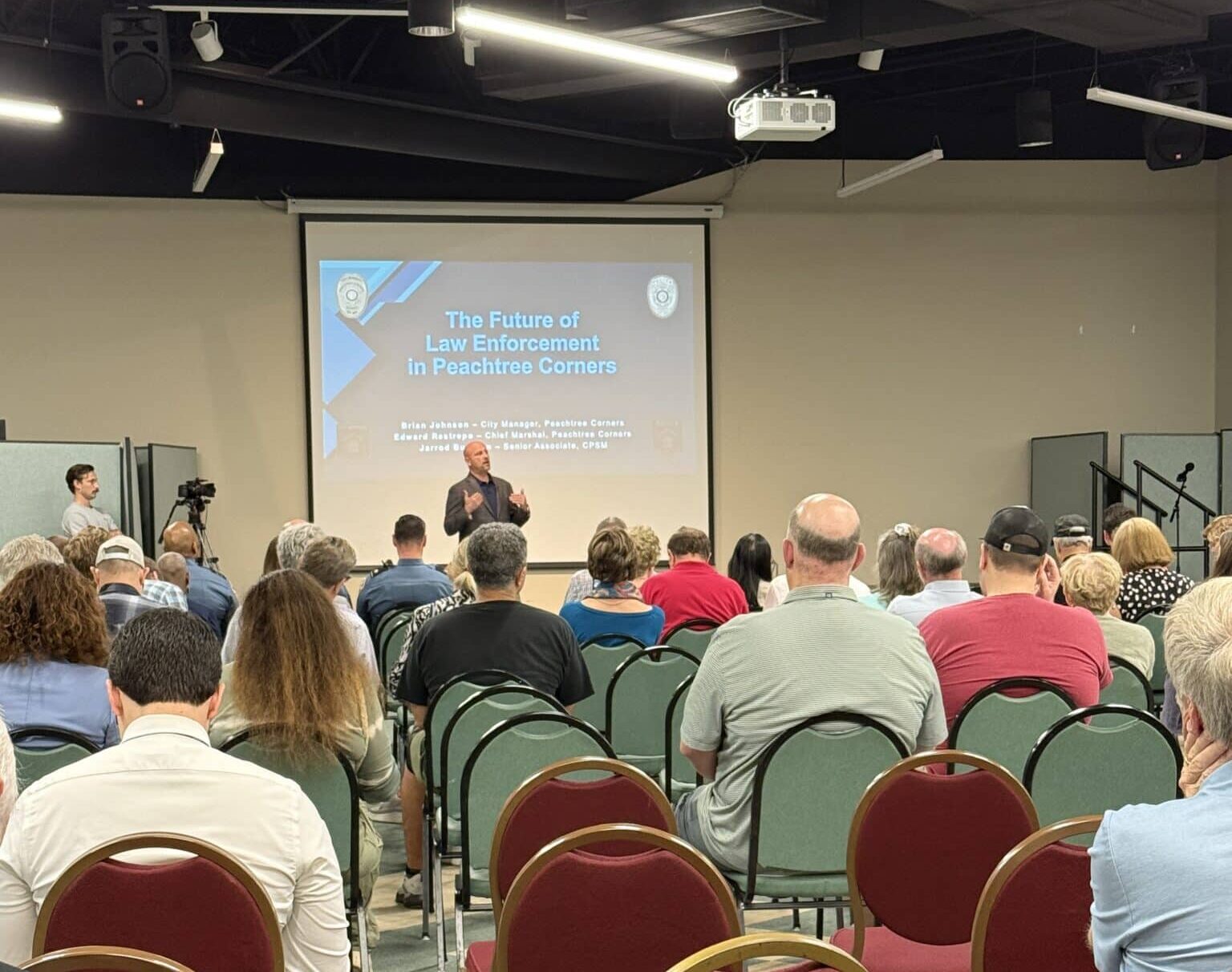
Although crime isn’t on the rise, and the Gwinnett County Police Department (GCPD) is fulfilling its role in fighting crime, the City of Peachtree Corners is asking residents, business owners and city stakeholders if they believe the city should form its own police department.
With over 100 people in attendance, City Manager Brian Johnson led the discussion about the future of policing in Peachtree Corners. He presented the findings from a survey conducted by the Center for Public Safety Management (CPSM), a nationally-recognized law enforcement consulting and training firm, as well as information about patrol officer staffing, response times, costs to tax payers and a potential timeline.
Ensuring public safety
Johnson kicked off his presentation by explaining that it is the duty of the mayor and city council to ensure public safety, including reviewing law enforcement.
“Maybe it needs to grow, maybe it needs to change its focus. But city council is the one that has the decision-making responsibility,” he said.
He was also adamant that this isn’t a done deal.

“I hit this point already, but I want to hit it again. This is the start of a conversation, a community conversation and feedback to council. There hasn’t been a decision,” he said. “Council has not received this presentation from me. They’re here to watch and learn from your feedback of this.”
Mayor Mike Mason was present at the meeting, along with all of the city council members except Eric Christ who was out of town and watching remotely.
Issues and obstacles
Johnson explained that the grounds for the inquiry were based on issues about communication, access to information and enforcement of city-specific ordinances. He cited an example where a city rule that private residences can’t be rented on a short-term basis like Vrbo or Airbnb wasn’t enforced by GCPD. An owner tried to circumvent the ordinance by only renting the outside of the house. A loud pool party ensued, and frustrated neighbors dialed 911.
“Officers showed up and they said, ‘We can’t enforce the city’s noise ordinance,’” Johnson said.
The first stage to fix this problem was creating the marshal program to bridge the gap between code enforcement and GCPD.
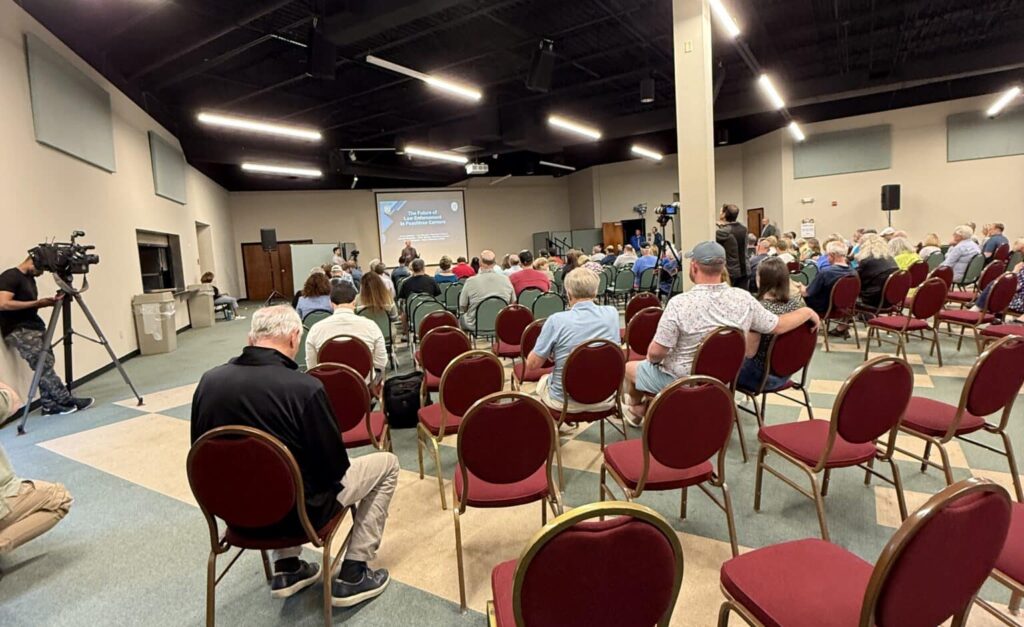
“[We thought] they would be able to enforce both local ordinance and state law, since they are a function of the city, and they could maybe be a force multiplier for Gwinnett since [marshals] don’t have to respond to 911 calls,” said Johnson.
But other issues arose shortly after the department was formed.
“We were still working towards getting that good balance, but we have been faced recently with a couple of things that make it harder for us,” said Johnson.
Seeking shared access
Instead of GCPD giving PTC marshals read-only, quick access to incident reports, dispatch calls and other information, the marshals department was required to file open records requests through the same process as any civilian.
“They were denied, as well as the city of Sugar Hill, [when] asked for the ability to see, not change, but see the computer-aided dispatch information, so that they would know where Gwinnett County police officers were; so that they could avoid stepping on their toes or maybe looking to support their efforts, and they haven’t been granted that,” said Johnson.
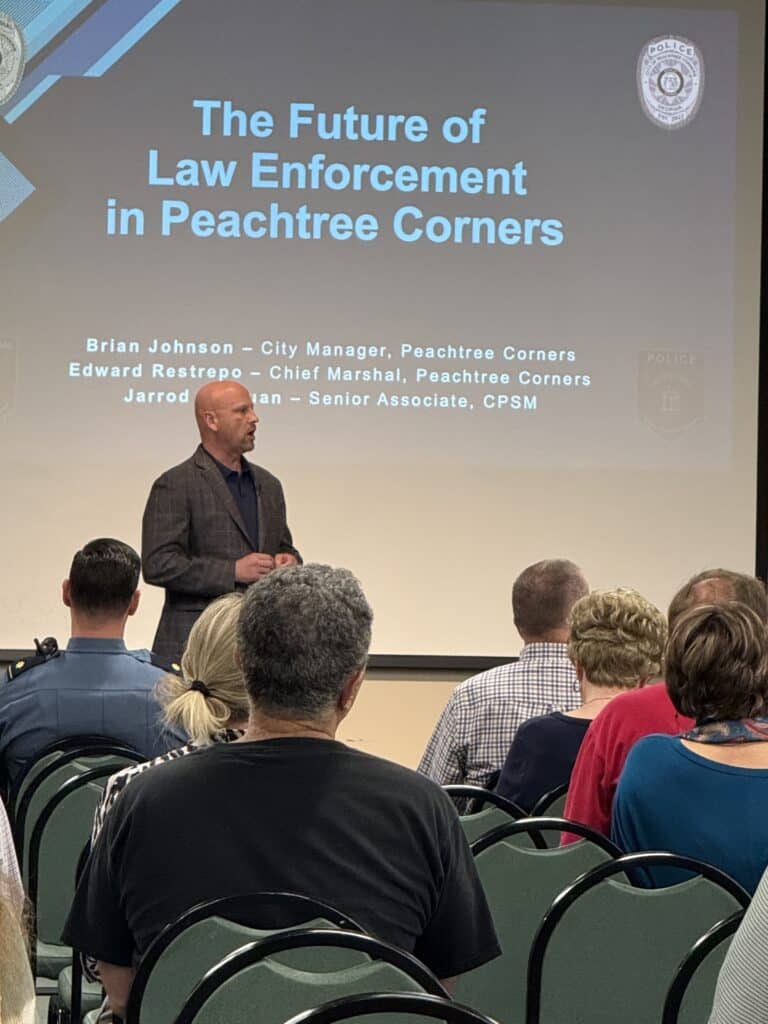
He added that the GCPD has video cameras on certain roadways that are used for various reasons, and law enforcement can use them when there’s crime in the area. Peachtree Corners marshals were denied access to those cameras.
“Conversely, we have a couple hundred cameras in the city, and we definitely want them to have access to them,” said Johnson. “So the frustration out of not being able to get that symbiosis between the marshals and police made us start thinking, all right, you know, is there another option?”
Community feedback
CPSM utilized data from GCPD to discern if Peachtree Corners could feasibly stand its own force. It also took into consideration crime trends, costs and many other factors. It recommended a 55-officer department, costing $12.1 million annually, with a $2.2 million upfront cost.
Comparing the two options to “renting vs. owning” the primary law enforcement agency in the city, Johnson presented pros and cons for each. Once the question-and-answer portion began, there was no obvious choice. Men and women, young and more advanced in age, had both similar and differing opinions.
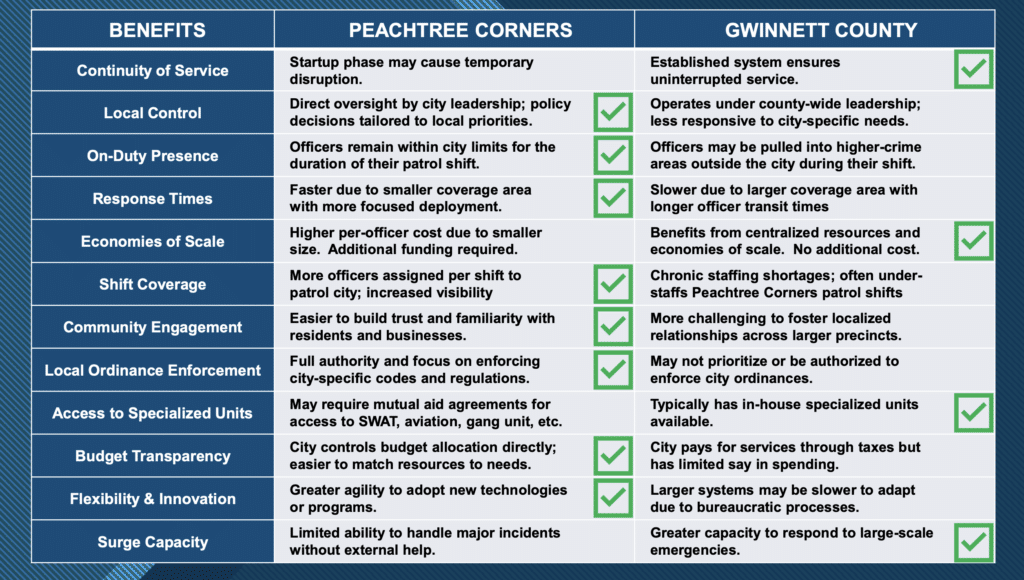
One young man, who identified himself as a local small business owner named Alexander, argued that with artificial intelligence increasing the efficiency of administrative tasks, perhaps the city wouldn’t need a full 68-man department of civilians and sworn officers.
Some accused the city of devising a solution in need of a problem. Others were concerned that paying approximately $100,00 for a study was throwing good money after bad.
But at the end of it all, the city is continuing to seek feedback and is encouraging everyone to make informed decisions. The meeting was taped and is available on the city website along with Johnson’s PowerPoint presentation, a copy of the study done by CPSM and a survey.
As far as a timeline goes, city officials would like folks to take the summer to mull it over and come back in the fall to take another look at the proposal.
Related
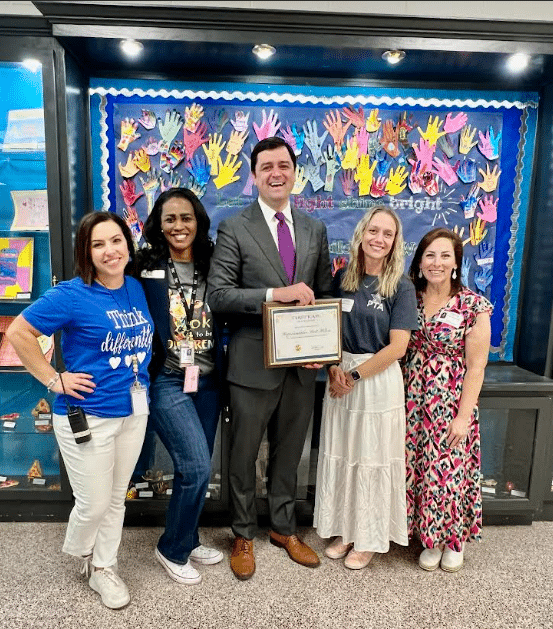
Simpson Elementary School celebrated Exceptional Children’s Week (ECW) last month with five days of special activities to recognize their special needs population and all of their exceptional students.
April 14–18 is set aside each year to celebrate children with disabilities, gifts and talents. This year’s ECW theme was Bridging Gaps and Building Futures, and the school was happy to take part.
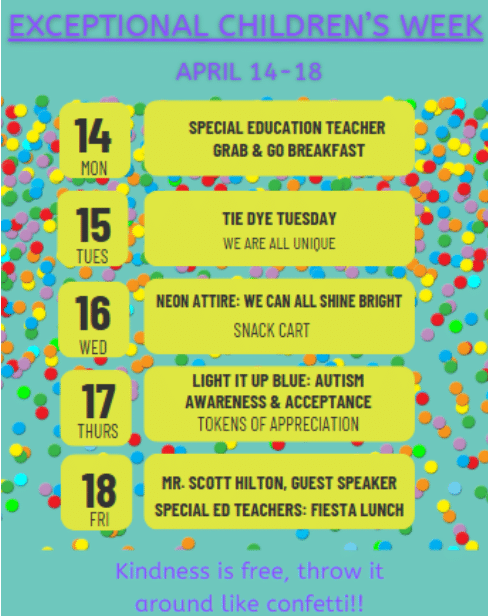
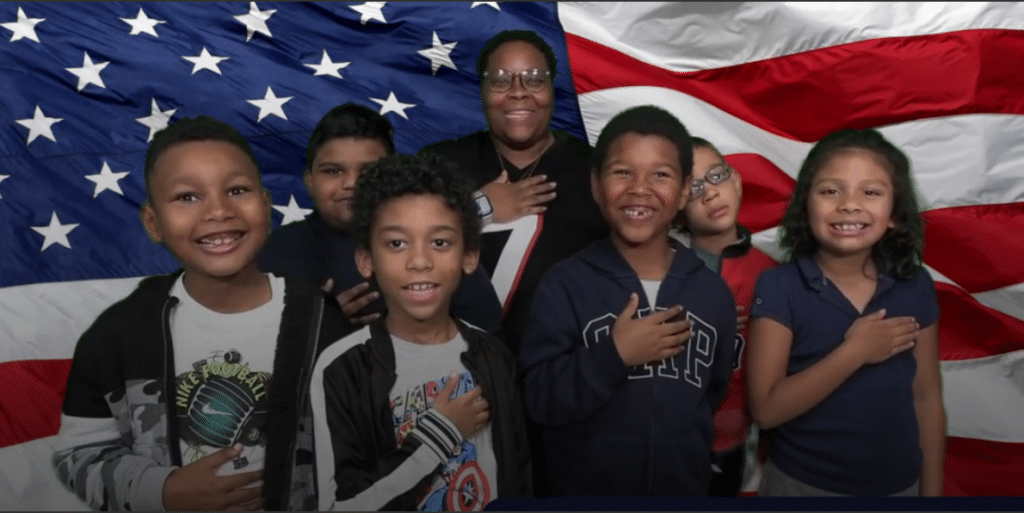
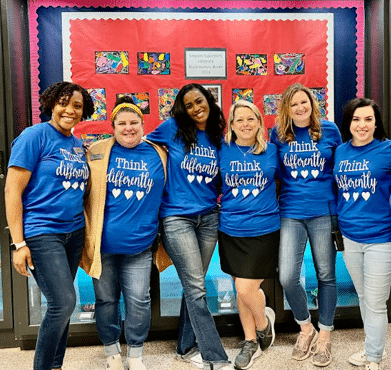
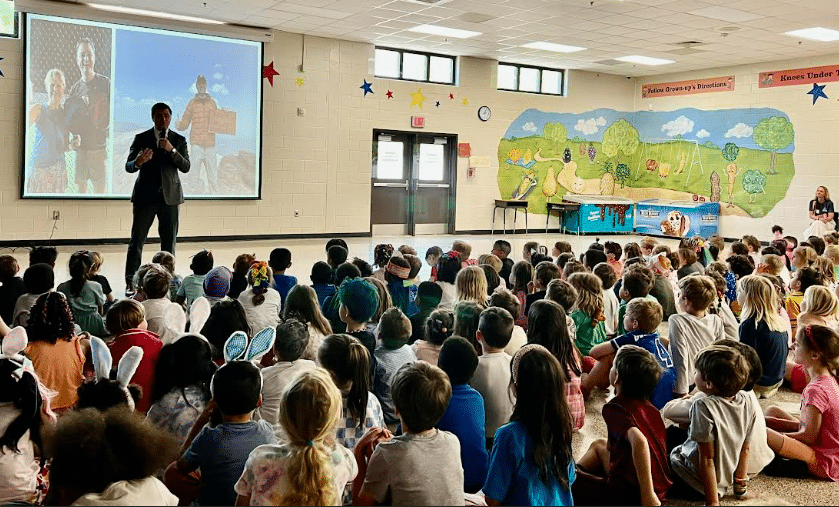
They highlighted each day of the week on the morning news with fun facts about notable people in society — and throughout history — who have overcome challenges with their disabilities, including actor Daniel Radcliffe (who has lived with dyspraxia for his entire life), Tom Cruise, Whoopi Goldberg, Frida Kahlo and Helen Keller.
Simpson Elementary’s technology team also pre-recorded various special needs classes reciting the Pledge of Allegiance every day of the week.
Guest speaker
To end their ECW with a bang, they invited former Simpson Elementary parent, State Representative Scott Hilton, to come in and speak to their K-2 classes about raising his son, Chase (who is autistic and now a student at Norcross High School), and how being different is okay.
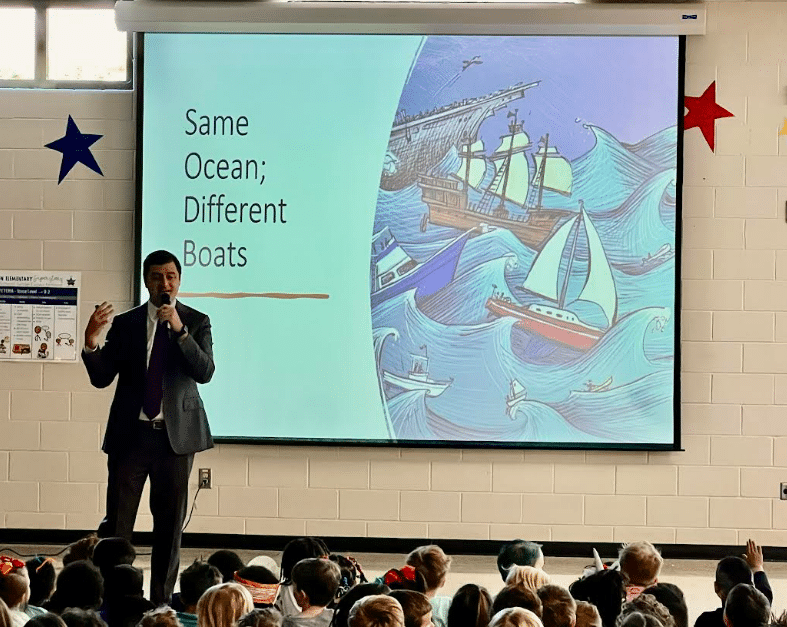
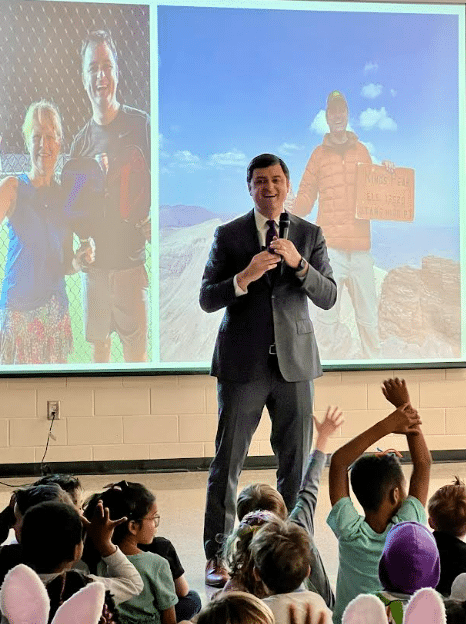
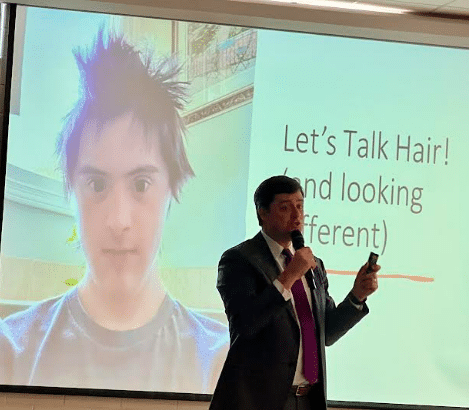
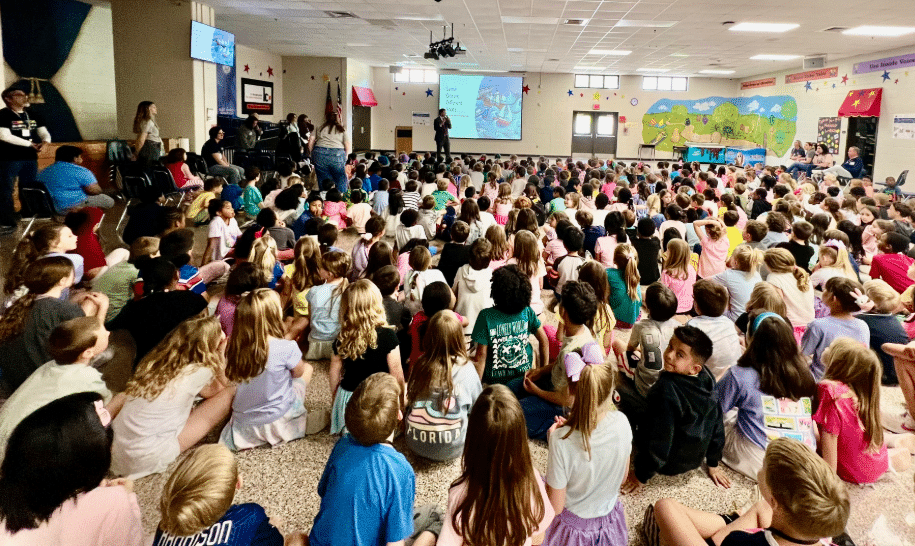
“Showing kindness and being inclusive is the best version of humanity,” said Dr. Taffeta Connery, Simpson Elementary School principal, in a statement about the event.
“Simpson Elementary has a special needs population of 214 (23%) of 946 students. [And] … we strive to ensure that our students are valued, recognized and instilled with high expectations for all.”
For more about Simpson Elementary, visit simpsones.gcpsk12.org.
Related
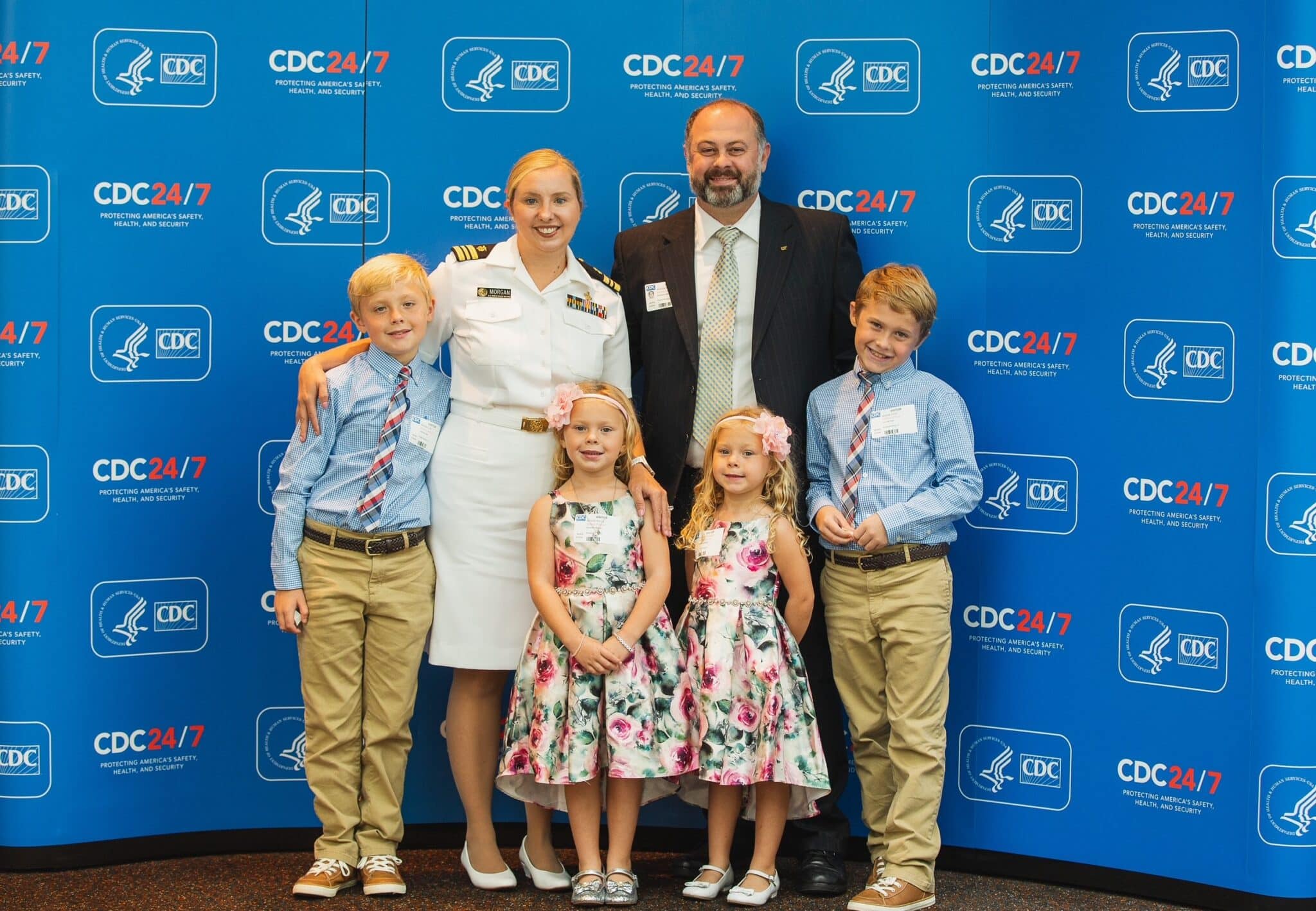
Motherhood comes with a lot of moving parts. For these Peachtree Corners moms, it also means leading teams, building careers and keeping the family schedule running. Most days, all at once.
This Mother’s Day, we’re spotlighting seven women in our community who are doing just that. They’re professionals in full-time leadership roles, showing up to strategy meetings by day and soccer games by night. They’re problem-solvers, planners, caregivers and coaches.
What connects them most isn’t just what they do, it’s how they do it. With intention. With humor. With support from partners, parents, friends and neighbors. And with a deep appreciation for the community they’ve built in Peachtree Corners.
Through their stories, we celebrate more than titles and to-do lists. We honor the quiet, constant work of showing up.
Tracy Lee
Tracy Lee leads with heart and vision as CEO of This Dot Labs, a software consultancy focused on helping businesses solve complex challenges through technology. Her engineering leaders collaborate with major clients like Stripe, DocuSign, Google, Wikipedia and Roblox. She’s passionate about her work.
“I love the mix of problem-solving and people leadership and knowing the work we do can make a real-world impact,” she said.
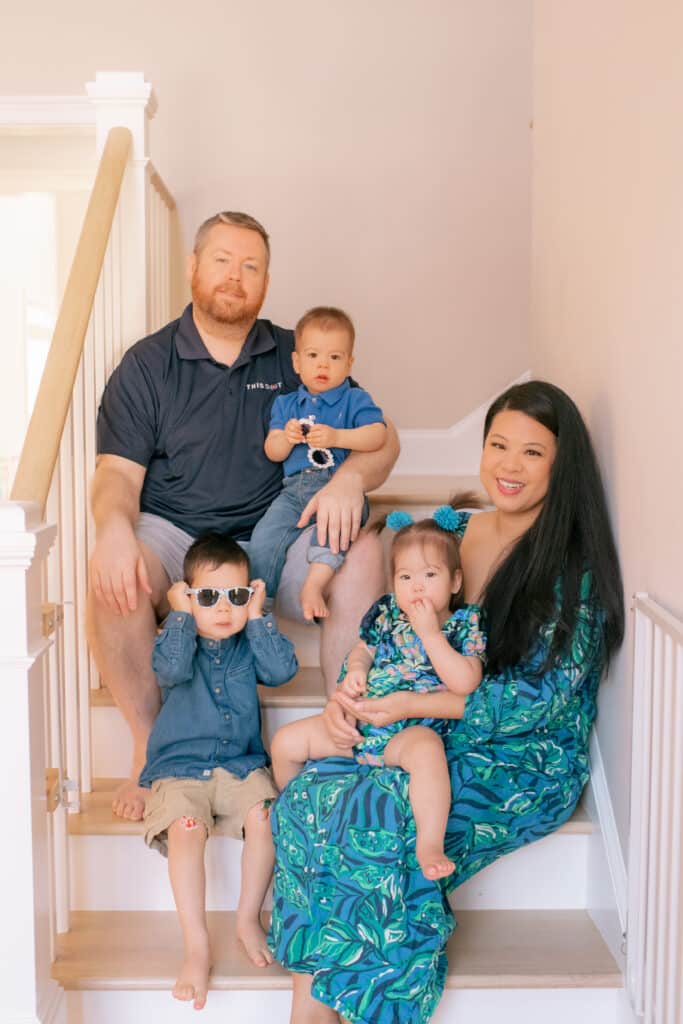
Tracy brings that same intentionality to her life at home, where she and her husband, Elliott Fouts, are raising three young children: William, 3, and twins Angelina and Marcus, who are 1.5. Despite the busy pace, Tracy is committed to being present in every role she plays.
“I have three full-time nannies and two part-time nannies, as well as girls around the neighborhood who are mama’s helpers to manage the chaos! With the help, we are able to do more and enjoy more time with our kids,” she said. “I try to be fully present, whether I’m in a meeting or building block towers in the living room. It’s never perfect, but we focus on what matters most in the moment.”
Tracy credits her support system for making it all possible. “I have an incredible partner and a strong support system between our nannies, friends and local community,” she said. “We have a local moms group for Asian moms called Georgia Asian Moms, and there are so many moms just in our neighborhood. It’s really great.”
Peachtree Corners has become a meaningful home base for the family. “We absolutely love it here,” she said. “There’s amazing programming for kids at The Forum every Tuesday in the spring and summer. It’s such a gem for young families.”
Weekends often include time outside and community adventures. “Sometimes the best hack is just piling everyone in the wagon and heading out for fresh air!” she said.
Tracy leans on a strong partner, a tight-knit group of friends and a local moms network. “It really takes a village,” she shared. “And I feel lucky to have one.”
Melissa Nicholson
Melissa Nicholson knows what it means to lead with heart and precision. As division vice president of program management & international solutions at Aya Healthcare, she helps internationally educated healthcare professionals enter the U.S. workforce.
“What I enjoy most is the opportunity to support these professionals in achieving their American dream,” she said. “While also contributing to improved patient outcomes across the country.”
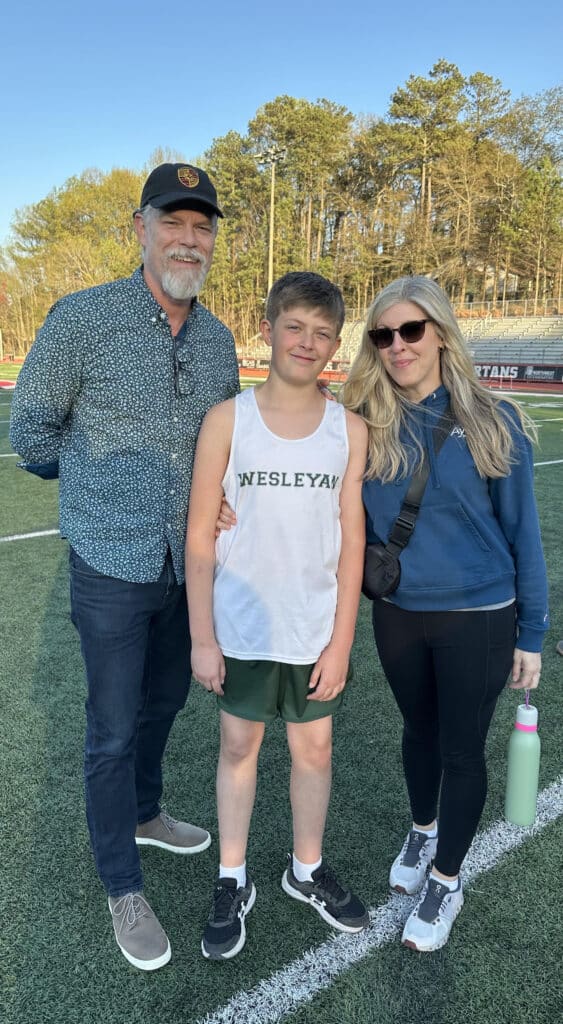
Melissa and her husband Greg recently celebrated 15 years of marriage. Their 12-year-old son, Luke, and a cat named Charlie bring a fun, loving dynamic of their own into the family. After relocating from East Atlanta a decade ago, they quickly embraced the Peachtree Corners community.
“It’s the people who make this community so special,” she said. “We’re truly grateful to count our neighbors as friends.”
Balancing an executive role with family life takes clarity and commitment. “I have to be very intentional with my time,” Melissa shared. She sets boundaries at work and makes sure her team knows when she’s off the clock for important family moments.
Wellness is a key part of her rhythm. “I recently started working out at Orangetheory Fitness,” she said. “I’ve noticed a significant boost in both energy and focus.” Sundays are for church and reflection.
When she travels for work, Greg holds it down at home. “We rely on each other to keep life running smoothly,” she said. “I’m grateful every day for that kind of partnership.”
On weekends, Melissa prioritizes quality time. Whether that’s a hike, pool day or baking something from scratch. “We’ve learned that if we don’t prioritize those moments, the weekends can quickly get taken over.”
Diva Hicks
For Diva Hicks, work isn’t just a job, it’s personal. As creative senior manager at CURE Childhood Cancer, her mission runs deep.
“At 12 years old, my sister was diagnosed with cancer,” she said. “CURE, in its early days, was a resource for my family.”

Her sister survived and now thrives. That experience shaped Diva’s career and continues to inspire her today. “This is my opportunity to give back to CURE for what it did for my family,” she said. “It’s rare to find a place where your purpose and passions collide.”
CURE also welcomes her whole family into the fold. “I get to bring my kids to events all the time,” she said. “They love feeling like they are a part of my work.”
Diva lives in Peachtree Corners with her husband John, their children Adair, 8, and Tripp, 6, and two golden doodles. “There is a sense of community here that I think is special,” she said.
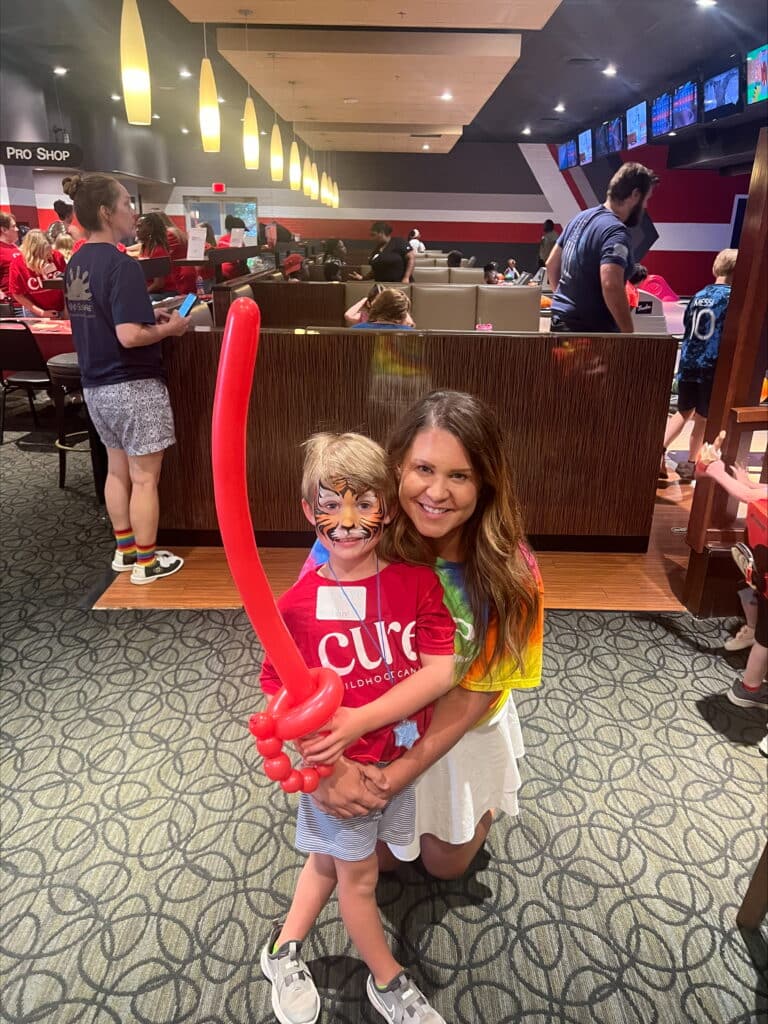
Balance is a daily effort. “John and I have tackled who helps with homework and on what days,” she said. “I would not be able to be the mom that I am without my village.”
She leads school committees and never misses events. “Is it easy? No,” she said. “But I honestly say, it’s not easy for any parent.”
Diva’s motivation is clear. “I want Adair to look at me and see that she can be a mom and have a career too.”
The family stays grounded with tennis weekends and careful planning. “We live by our calendar,” she said. “The more prepared I am, the easier life is.”
Kate Martin
Kate Martin knows how to bring structure to busy systems. As senior director of financial planning and analysis at Alloy Roofing, she finds energy in collaboration and clear strategy.
“In this role, I work closely with various teams across the business,” she said. “It supports the company’s strategy and performance.”
Kate and her husband, Nathan, are raising two children, 14-year-old Elliot and 10-year-old Evan, in Peachtree Corners. After ten years in the area, she credits the people for making it feel like home. “Life wouldn’t be the same without the relationships we’ve built here,” she said.
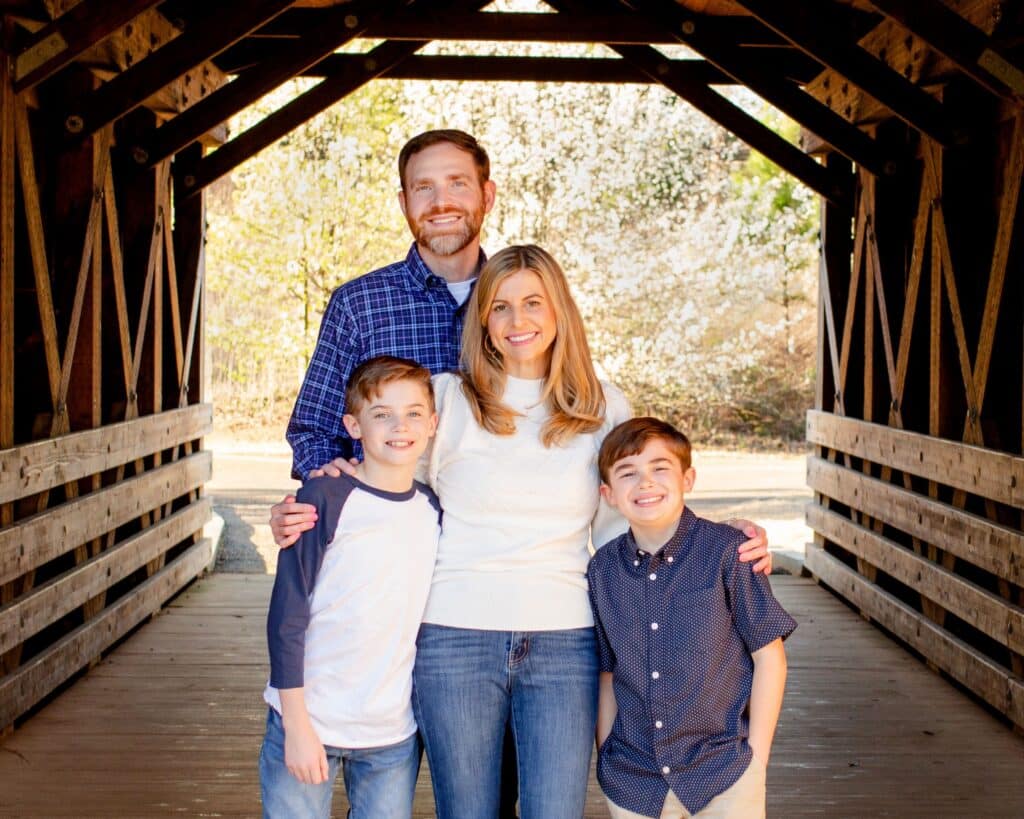
Balance starts with planning. “We keep a central Google calendar synced with all the family commitments that we review daily,” she said. “On Sundays we write on the kitchen boards.” Their chalkboard becomes the weekly roadmap, from meals to responsibilities.
“Seeing things laid out visually keeps me from overcommitting,” she added.
The family stays grounded by recognizing progress. “What keeps me motivated is celebrating both the big and small wins together,” she shared. “Sometimes, making it through the week is a victory in itself.”
Kate relies on a strong network. “We are very fortunate to have my parents nearby,” she said. “I also have an amazing network of women here in Peachtree Corners that I rely on.”
Her favorite hack? “An app Nathan created to help manage our calendars,” she said. “He created a solution to integrate these webcal subscriptions into a central subscription hub.” It’s called Skedj, and they’re piloting it now. “If you know this struggle and want to help us pilot the app, check out skedj.co!”
Linda Luna
As vice president at RSUI, Linda Luna manages risk while empowering people. She leads a team of underwriters who handle professional liability and cyber insurance. “I really enjoy my job because of its dynamic nature and the opportunity to help people in meaningful ways,” she said.
Whether she’s mentoring her team or protecting clients’ businesses, Linda finds value in impact. “It’s rewarding to know that my work has a positive impact on both my colleagues and our clients.”
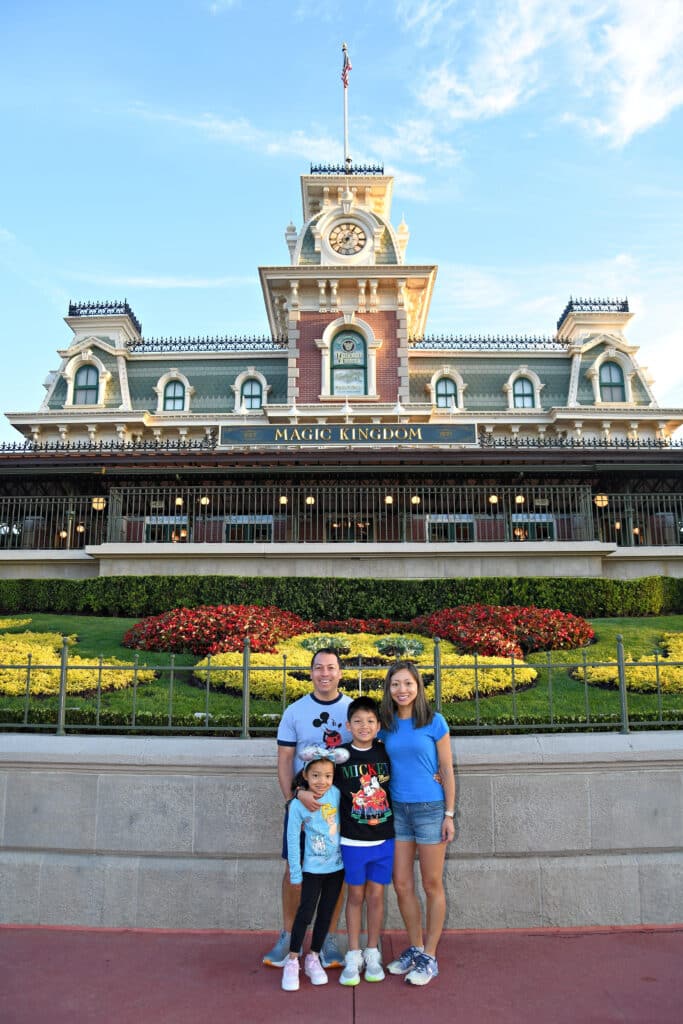
She and her husband, Ruben, are raising their two children, Dawson, 10, and Ava, 6, in Peachtree Corners. Her parents, though not under the same roof, are a constant part of daily life. “They help keep things running smoothly on the home front,” she said.
After nine years in the community, Linda has grown to love its blend of charm and convenience. “There is always something to do,” she said. “Whether it’s grabbing a bite at Ted’s or spending time with friends at Town Center.”
Balance comes from structure. “By establishing a solid schedule and sticking to it, I can ensure that my work commitments are met,” she said. “Being fully present allows me to strengthen my connection with my loved ones.”
When things get busy, she takes a practical approach. “Breaking it down into smaller, manageable tasks makes it much more approachable,” she said. “I remind myself to keep the bigger picture in mind and not sweat the small stuff.”
Linda’s support system is strong. “It truly takes a village, and I’m so grateful for mine,” she said. The family’s favorite tradition? A beach trip to 30A every May. “It’s our way of unwinding, reconnecting and making lasting memories together.”
Allison Blasetti
Allison Blasetti holds a national leadership role at Transamerica in the employee benefits division — a position that constantly challenges and motivates her. “What I enjoy most is the opportunity to use my talents to help my team,” she said. “I’m always growing and learning.”
She and her husband, John, are raising daughters Annie Mae, 8, and Olive, 6, in Peachtree Corners, where they’ve built strong ties in the community. “The amenities in our city provide many opportunities to run into friends around town or plan meet-ups,” she said.
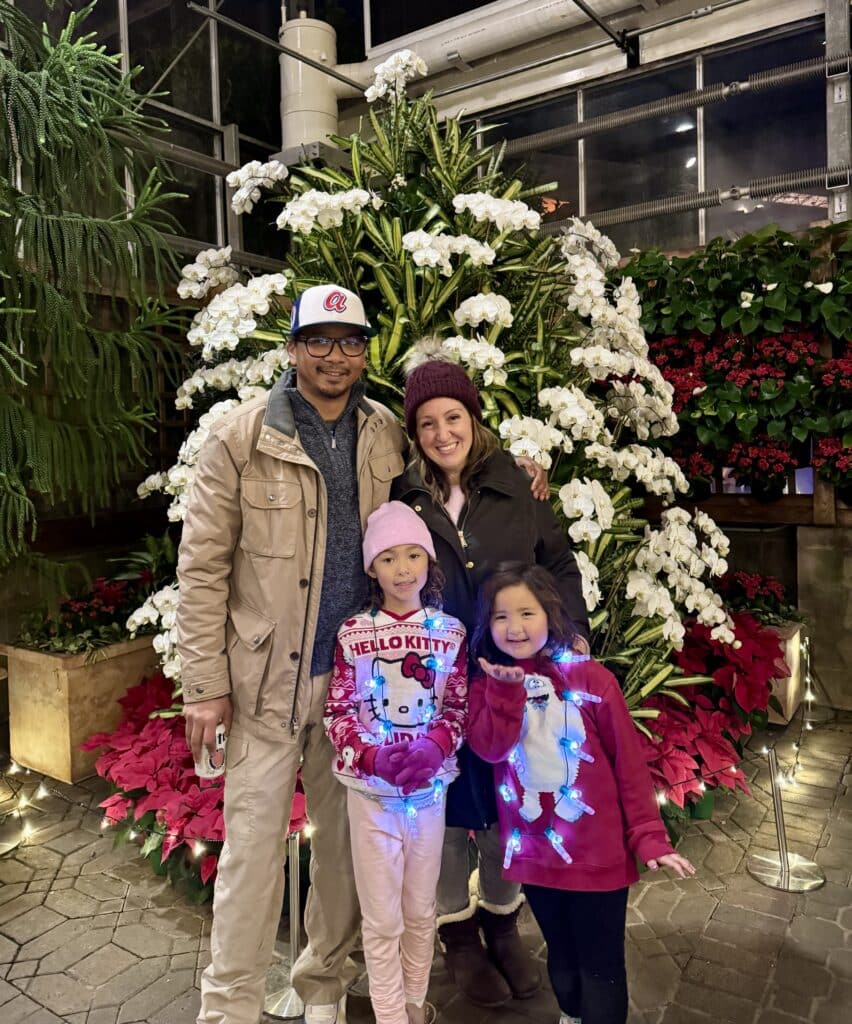
Allison works from home and prioritizes clear boundaries. “I turn off my app notifications because it quickly pulls me back in to work,” she said. “I also have a dedicated workspace in my house where I can leave at the end of the workday.”
She’s developed the habit of resetting her mindset, as well. “I quickly recognize [when] I’m mentally ‘at work’ and actively redirect my thoughts back to being in the present moment.”
Allison’s mornings begin at Burn Bootcamp, where she finds motivation and connection. “Spending an hour with my Burn community helps me get grounded for the day,” she said.
To stay organized, she and her husband use a shared family calendar. Her mom steps in often, especially when work travel ramps up. “I really don’t know what we would do without her.”
On weekends, Allison coaches Olive’s soccer team with the Peachtree Corners Football Club. “It brings me so much joy to be outside, see my soccer friends and watch my girls have fun,” she said. “Coaching makes it even better because I get to support the community that means a lot to me.”
Samantha Morgan
Samantha Morgan is a commander in the U.S. Public Health Service, currently assigned to the Centers for Disease Control and Prevention. Over her career, she’s responded to major public health threats, including Ebola, Zika and COVID-19. Today, her work centers on injury prevention, with a focus on issues like suicide, drowning and traumatic brain injury.
“What I enjoy most is being part of CDC’s mission to save lives and protect people,” she said. “I’m proud to contribute to work that makes a tangible difference in communities across the country.”
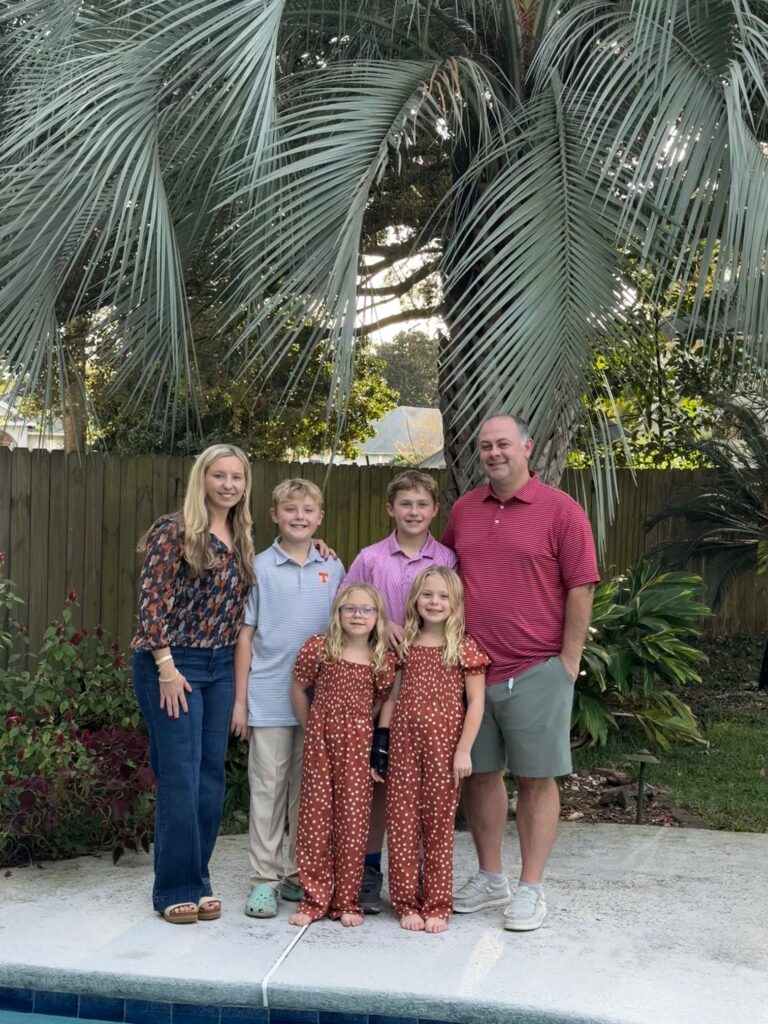
At home in Peachtree Corners, Samantha and her husband, Brian, are raising two sets of twins. Luke and Elliot are 12-years-old and love baseball, golf, basketball and band. Charlotte and Noelle are 8-years-old and enjoy piano, tumbling and tennis. “Life with four kids is wonderfully busy,” she said. “I often joke that I’m an unpaid Uber driver!”
After more than a decade in the neighborhood, Samantha credits their support system for helping them manage the day-to-day. “Our neighbors and friends — our village — have supported us through the hardest moments and celebrated life’s greatest joys with us,” she said.
Structure is key to keeping things on track. “We live and breathe by our family calendar,” she said. “Shared schedules, group texts and carpooling help us keep things running.”
Her children remain Samantha’s biggest motivators. “They know, ‘mom’s going to work to help make the world a safer place,’” she said.
The family also leans on routines and simple joys. “Checklists are my go-to mom hack,” she shared. One of their favorite traditions is make-your-own-pizza night. “It’s messy, silly and something we all genuinely look forward to.”
The seven women featured here offer a glimpse into the lives of working moms in Peachtree Corners. Each one balances career, family and community with care and intention. They are just a few of the many women — both working and stay-at-home — who nurture, organize and uplift the people around them every day.
Whether leading teams or guiding their children, mothers across this community show up with strength, love and quiet determination.
You’ll find this story in the May/June issue of Peachtree Corners Magazine, available in print and digital edition.
Related
Read the Digital Edition
Subscribe
Keep Up With Peachtree Corners News
Join our mailing list to receive the latest news and updates from our team.
You have Successfully Subscribed!

Peachtree Corners Hosts Discussion About the Future of Local Policing

D1 Training Brings New Fitness Concept to Peachtree Corners

MomoCon 2025 to bring 60,000 Fans to Atlanta for a Weekend of Cosplay, Animation, Gaming and Music

City of Peachtree Corners Awarded Certificate of Achievement From GFOA for Seventh Straight Year

Atlanta’s Dog Howl-O-Ween Festival Moving to Peachtree Corners for 2025

Local Special Olympics Pickleball Team Honored with State House Resolution

From Boardrooms to the Himalayas: Vandana’s Journey to Purpose and Growing with Intention [Podcast]

Brandon Branham Honored for Transformative Leadership in Peachtree Corners

Music Matters Productions Expands Peachtree Corners Headquarters

Brandon Branham Honored for Transformative Leadership in Peachtree Corners

From Boardrooms to the Himalayas: Vandana’s Journey to Purpose and Growing with Intention [Podcast]

MomoCon 2025 to bring 60,000 Fans to Atlanta for a Weekend of Cosplay, Animation, Gaming and Music

Local Special Olympics Pickleball Team Honored with State House Resolution

Atlanta’s Dog Howl-O-Ween Festival Moving to Peachtree Corners for 2025

D1 Training Brings New Fitness Concept to Peachtree Corners

Peachtree Corners Hosts Discussion About the Future of Local Policing

Light up the Corners [Video]

Capitalist Sage: Business Leadership in Your Community [Podcast]

Cliff Bramble: A Culinary Adventure through Italy

Top 10 Brunch Places in Gwinnett County

A Hunger for Hospitality

THE CORNERS EPISODE 3 – BLAXICAN PART 1

Top 10 Indoor Things To Do This Winter

The ED Hour: What it takes to Remove Barriers from Education

Peachtree Corners Life
Topics and Categories
Trending
-
Around Atlanta5 days ago
MomoCon 2025 to bring 60,000 Fans to Atlanta for a Weekend of Cosplay, Animation, Gaming and Music
-
Business2 days ago
From Boardrooms to the Himalayas: Vandana’s Journey to Purpose and Growing with Intention [Podcast]
-
City Government24 hours ago
Brandon Branham Honored for Transformative Leadership in Peachtree Corners
-
Business1 hour ago
Music Matters Productions Expands Peachtree Corners Headquarters







